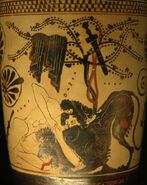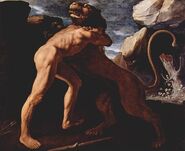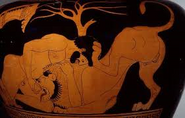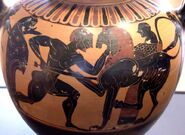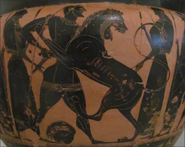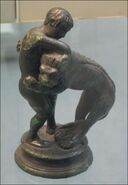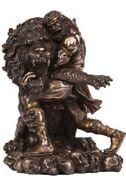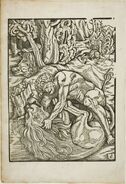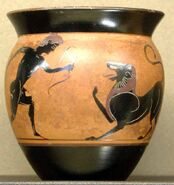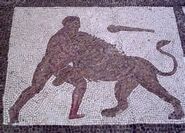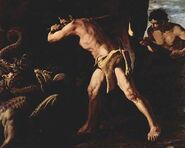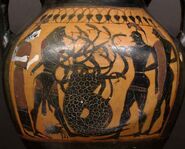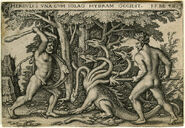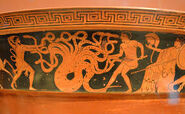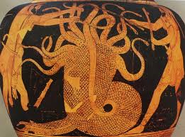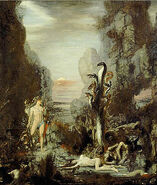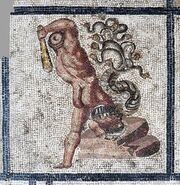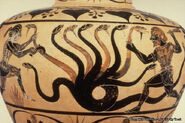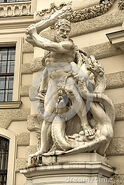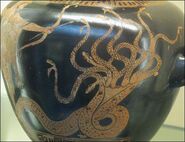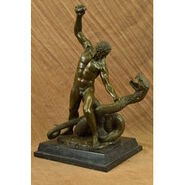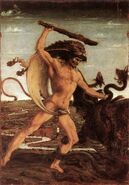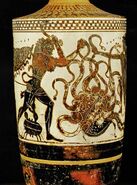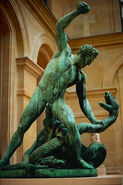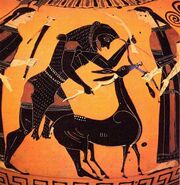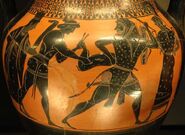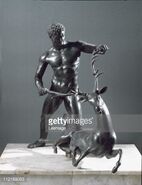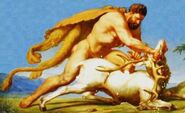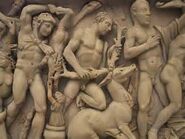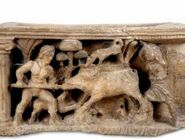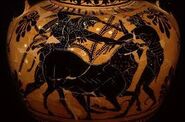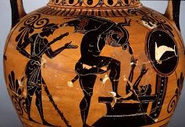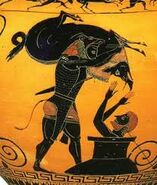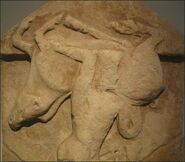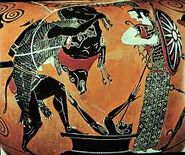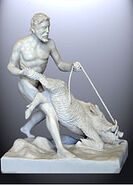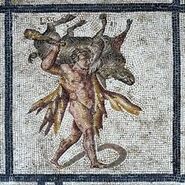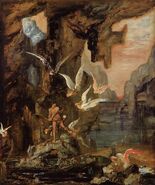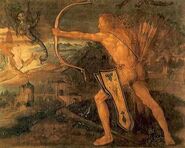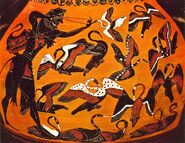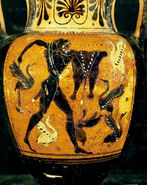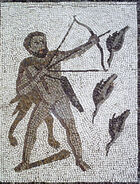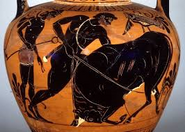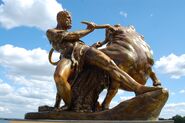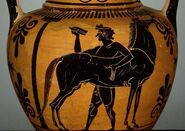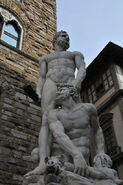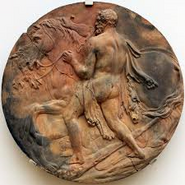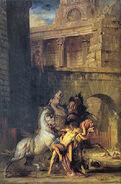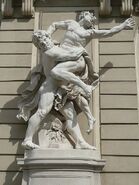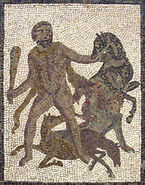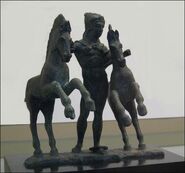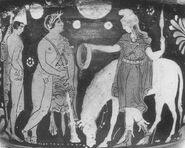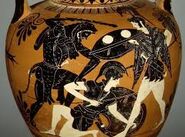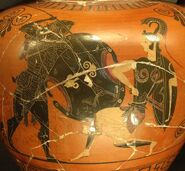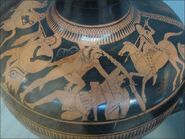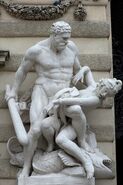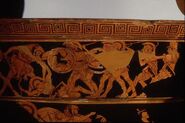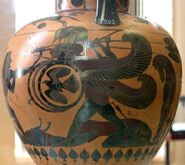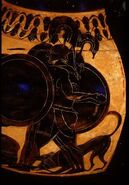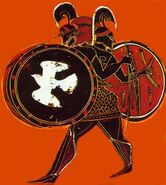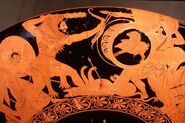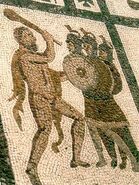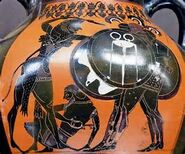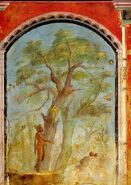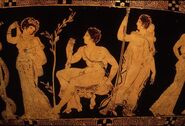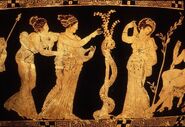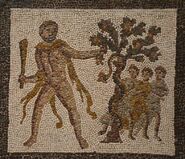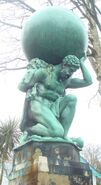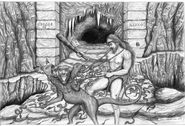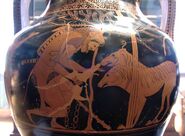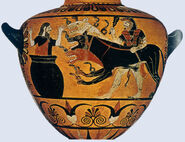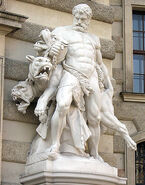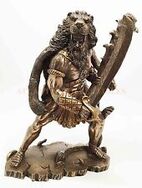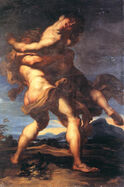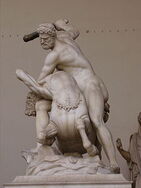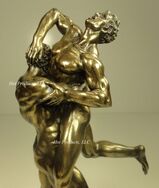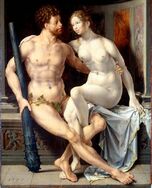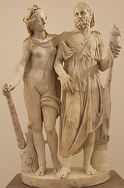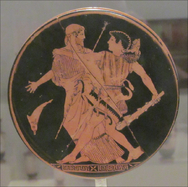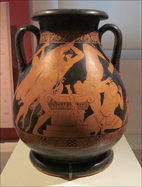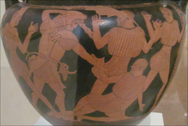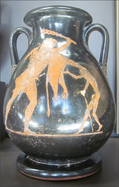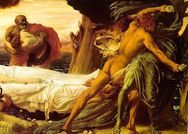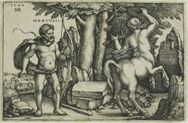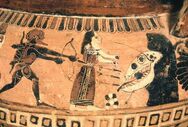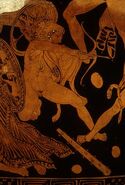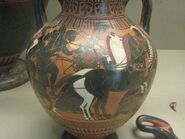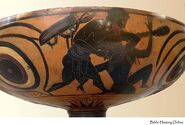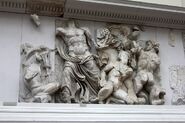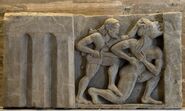А Б В Г Д Е Ж З И Й К Л М Н О П Р С Т У Ф Х Ц Ч Ш Щ Э Ю Я
Гера́кл, -а
Рядом по алфавиту:
гепа́то-церебра́льный
гепатопто́з , -а
гепатохолецисти́т , -а
гепатоци́ты , -ов, ед. -ци́т, -а
гепатромби́н , -а
гепи́ды , -ов (племенная группа, ист.)
гепта́метр , -а
гепта́н , -а
гептафтори́д , -а
гептахло́р , -а
гептахо́рд , -а
гепта́эдр , -а
гепти́л , -а
гепто́д , -а
Ге́ра , -ы
Гера́кл , -а
Геракли́тов , -а, -о и геракли́товский (от Геракли́т)
гера́льдика , -и
геральди́ст , -а
геральди́ческий
гера́невый , и гера́ниевый
геранио́л , -а
гера́нь , -и
гера́нька , -и, р. мн. -нек
Гера́сим-грачо́вник , Гера́сима-грачо́вника (день народного календаря)
гера́тский , (от Гера́т)
герб , герба́
гербала́йф , -а
гербариза́ция , -и
гербаризи́рованный , кр. ф. -ан, -ана
гербаризи́ровать(ся) , -рую, -рует(ся)
Правило
Лексема «Геракл» является именем собственным, поэтому всегда пишется с прописной буквы.
Написание безударной гласной «е» объясняется тем, что имя возникло в греческом языке и дословно переводилось как «слава Гере» (богине семьи). В лексеме «Гера» в сильной позиции находится «е», которая позволяет проверить гласную в слове «Геракл».
Значение
Геракл — герой греческой мифологии. Сын Зевса и обычной женщины. Прославился, совершив 12 подвигов.
Примеры
- Геракл получил новое задание от царя Эврисфея.
- Геракл был почитаем греками не только как герой, но и как бог.
- Именно Геракл прекратил мучения Прометея, убив орла, истязающего его.
Гера́кл
Гера́кл, -а
Источник: Орфографический
академический ресурс «Академос» Института русского языка им. В.В. Виноградова РАН (словарная база
2020)
Делаем Карту слов лучше вместе
Привет! Меня зовут Лампобот, я компьютерная программа, которая помогает делать
Карту слов. Я отлично
умею считать, но пока плохо понимаю, как устроен ваш мир. Помоги мне разобраться!
Спасибо! Я обязательно научусь отличать широко распространённые слова от узкоспециальных.
Насколько понятно значение слова заделка (существительное):
Ассоциации к слову «Геракл»
Синонимы к слову «Геракл»
Синонимы к слову «геракл»
Предложения со словом «геракл»
- Геракл попробовал выстрелить в него из лука, однако его стрелы не смогли пробить толстую шкуру животного.
- Геракл обозлился, в погоню кинулся, чуть их всех не перебил.
- Геракл убивал чудовищ, путешествовал в неизведанные земли, даже спускался под землю в царство духов умерших людей и вернулся невредимым.
- (все предложения)
Значение слова «Геракл»
-
Гера́кл (др.-греч. Ἡρακλῆς), Геркуле́с (лат. Herculēs) — в древнегреческой мифологии герой, сын бога Зевса и Алкмены — жены героя Амфитриона. При рождении был назван Алкидом (Ἀλκείδης). Неоднократно упомянут уже в «Илиаде» (II 658 и др.). (Википедия)
Все значения слова ГЕРАКЛ
Ответ:
Правильное написание слова — Геракл
Ударение и произношение — Гер`акл
Выберите, на какой слог падает ударение в слове — ЗАВИДНО?
или
Слово состоит из букв:
Г,
Е,
Р,
А,
К,
Л,
Похожие слова:
Гераклит
Толкование слова. Правильное произношение слова. Значение слова.
Синонимы слова «ГЕРАКЛ»:
БУГАЙ, ГЕРКУЛЕС, ГЕРОЙ, ЗДОРОВЫЙ КАК БЫК, КАЧОК, КУЛЬТУРИСТ, МЕЛЬКАРТ, ШКАФ
Смотреть что такое ГЕРАКЛ в других словарях:
ГЕРАКЛ
или Геркулес (Heracles, Hercules, Ήρακλής) — национальный греческий герой. Древнейший источник, где воспеваются его подвиги, — Гомер. У последнего, а также и у Гезиода, Г. является еще вполне греческим героем в вооружении героев доисторического периода и действует почти исключительно в пределах Греции. Впоследствии Пизандр, эпический поэт середины VII в., в своей Гераклее, от которой дошли до нас только отрывки, дал ему вместо обыкновенного оружия палицу и одел его в львиную шкуру. В то же время круг сказаний о нем стал постепенно расти; на него перенесли подвиги героев других народов, особенно финикийцев и египтян, и согласно восточным воззрениям привели его деятельность в связь с течением солнца. По представлению греков, Г. был сыном Зевса и Алкмены, жены тиринфского царя Амфитриона, сына Алкеева, внука Персея. В тот день, когда должен был родиться Г., Зевс имел неосторожность похвалиться в собрании богов, что явится на свет человек, который будет властвовать над всеми потомками Персея. Ревнивая Гера замедлила тогда роды Алкмены и вместо Геракла явился в тот день на свет Эврисфей, сын дяди его Сфенела. Когда, наконец, родились близнецы Г. и Ификл, Гера послала двух страшных змей к ложу младенцев, но Г. задушил их. Когда Г. в припадке гнева убил лирой своего наставника Лина, Амфитрион послал его пасти стада на Кифероне. Здесь он убил страшного киферонского льва, в шкуру которого — по другому сказанию, в шкуру немейского льва — он оделся так, чтобы пасть льва служила ему вместо шлема. За оказанную услугу Креон, царь фиванский, выдал за Г. свою дочь Мегару. Вскоре затем царствовавший над аргоссцами Эврисфей призвал Г. служить ему. Он должен был исполнить 12 работ, наложенных на него Эврисфеем, и по окончании их предназначен был Зевсом к бессмертию. Когда оракул объявил ему волю богов, он впал в безумие и в припадке бешенства умертвил своих собственных детей от Мегары и детей Ификла.Излечившись от безумия, Г. отправился в Тиринф ко двору Эврисфея. Из его работ у Гомера встречаем только рассказ о Цербере. Гезиод упоминает о борьбе с немейским львом, с лернейской гидрой и с Герионом. У поэтов более поздних, Пиндара и трагиков, перечислены все 12 работ. Полный цикл их, вероятно, впервые стал известен Пизандру. Эти работы следующие: 1) бой с немейским львом, которого Г. задушил в его собственной пешере своими руками. 2) Умерщвление лернейской гидры, ядом которой Г. обмазал свои стрелы, так что наносимые ими раны делались смертельными. 3) Охота на эриманфского вепря, опустошавшего Аркадию и пойманного им живьем. 4) Поимка керинитской, или менальской, лани с золотыми рогами и медными ногами. 5) Истребление стимфалийских птиц, снабженных медными когтями, крыльями, клювами и перьями, которыми они стреляли, как стрелами. 6) Приобретение пояса царицы амазонок Гипполиты для Адметы, дочери Эврисфея. 7) Очищение Авгиевых стойл, совершенное в один день путем провода через них реки, после чего Г., одолев Авгия и истребив его со всем его родом, учредил олимпийские игры. 
ГЕРАКЛ
или Геркулес (Heracles, Hercules, Ήρακλής) — национальный греческий герой. Древнейший источник, где воспеваются его подвиги, — Гомер. У последнего, а также и у Гезиода, Г. является еще вполне греческим героем в вооружении героев доисторического периода и действует почти исключительно в пределах Греции. Впоследствии Пизандр, эпический поэт середины VII в., в своей Гераклее, от которой дошли до нас только отрывки, дал ему вместо обыкновенного оружия палицу и одел его в львиную шкуру. В то же время круг сказаний о нем стал постепенно расти; на него перенесли подвиги героев других народов, особенно финикийцев и египтян, и согласно восточным воззрениям привели его деятельность в связь с течением солнца. По представлению греков, Г. был сыном Зевса и Алкмены, жены тиринфского царя Амфитриона, сына Алкеева, внука Персея. В тот день, когда должен был родиться Г., Зевс имел неосторожность похвалиться в собрании богов, что явится на свет человек, который будет властвовать над всеми потомками Персея. Ревнивая Гера замедлила тогда роды Алкмены и вместо Геракла явился в тот день на свет Эврисфей, сын дяди его Сфенела. Когда, наконец, родились близнецы Г. и Ификл, Гера послала двух страшных змей к ложу младенцев, но Г. задушил их. Когда Г. в припадке гнева убил лирой своего наставника Лина, Амфитрион послал его пасти стада на Кифероне. Здесь он убил страшного киферонского льва, в шкуру которого — по другому сказанию, в шкуру немейского льва — он оделся так, чтобы пасть льва служила ему вместо шлема. За оказанную услугу Креон, царь фиванский, выдал за Г. свою дочь Мегару. Вскоре затем царствовавший над аргоссцами Эврисфей призвал Г. служить ему. Он должен был исполнить 12 работ, наложенных на него Эврисфеем, и по окончании их предназначен был Зевсом к бессмертию. Когда оракул объявил ему волю богов, он впал в безумие и в припадке бешенства умертвил своих собственных детей от Мегары и детей Ификла.Излечившись от безумия, Г. отправился в Тиринф ко двору Эврисфея. Из его работ у Гомера встречаем только рассказ о Цербере. Гезиод упоминает о борьбе с немейским львом, с лернейской гидрой и с Герионом. У поэтов более поздних, Пиндара и трагиков, перечислены все 12 работ. Полный цикл их, вероятно, впервые стал известен Пизандру. Эти работы следующие: 1) бой с немейским львом, которого Г. задушил в его собственной пешере своими руками. 2) Умерщвление лернейской гидры, ядом которой Г. обмазал свои стрелы, так что наносимые ими раны делались смертельными. 3) Охота на эриманфского вепря, опустошавшего Аркадию и пойманного им живьем. 4) Поимка керинитской, или менальской, лани с золотыми рогами и медными ногами. 5) Истребление стимфалийских птиц, снабженных медными когтями, крыльями, клювами и перьями, которыми они стреляли, как стрелами. 6) Приобретение пояса царицы амазонок Гипполиты для Адметы, дочери Эврисфея. 7) Очищение Авгиевых стойл, совершенное в один день путем провода через них реки, после чего Г., одолев Авгия и истребив его со всем его родом, учредил олимпийские игры. 
ГЕРАКЛ
в древнегреческой мифологии величайший герой, сын бога Зевса и жены фиванского царя Алкмены. Среди многочисленных мифов о Г. наиболее известен … смотреть
ГЕРАКЛ
Геракл
Геркулес, Мелькарт
Словарь русских синонимов.
геракл
сущ., кол-во синонимов: 8
• бугай (27)
• геркулес (15)
• герой (80)
• здоровый как бык (8)
• качок (17)
• культурист (12)
• мелькарт (2)
• шкаф (51)
Словарь синонимов ASIS.В.Н. Тришин.2013.
.
Синонимы:
геркулес, герой, мелькарт… смотреть
ГЕРАКЛ
Геракл или Геркулес (Heracles, Hercules, Ήρακλής) — национальный греческий герой. Древнейший источник, где воспеваются его подвиги, — Гомер. У последнего, а также и у Гезиода, Г. является еще вполне греческим героем в вооружении героев доисторического периода и действует почти исключительно в пределах Греции. Впоследствии Пизандр, эпический поэт середины VII в., в своей Гераклее, от которой дошли до нас только отрывки, дал ему вместо обыкновенного оружия палицу и одел его в львиную шкуру. В то же время круг сказаний о нем стал постепенно расти; на него перенесли подвиги героев других народов, особенно финикийцев и египтян, и согласно восточным воззрениям привели его деятельность в связь с течением солнца. По представлению греков, Г. был сыном Зевса и Алкмены, жены тиринфского царя Амфитриона, сына Алкеева, внука Персея. В тот день, когда должен был родиться Г., Зевс имел неосторожность похвалиться в собрании богов, что явится на свет человек, который будет властвовать над всеми потомками Персея. Ревнивая Гера замедлила тогда роды Алкмены и вместо Геракла явился в тот день на свет Эврисфей, сын дяди его Сфенела. Когда, наконец, родились близнецы Г. и Ификл, Гера послала двух страшных змей к ложу младенцев, но Г. задушил их. Когда Г. в припадке гнева убил лирой своего наставника Лина, Амфитрион послал его пасти стада на Кифероне. Здесь он убил страшного киферонского льва, в шкуру которого — по другому сказанию, в шкуру немейского льва — он оделся так, чтобы пасть льва служила ему вместо шлема. За оказанную услугу Креон, царь фиванский, выдал за Г. свою дочь Мегару. Вскоре затем царствовавший над аргоссцами Эврисфей призвал Г. служить ему. Он должен был исполнить 12 работ, наложенных на него Эврисфеем, и по окончании их предназначен был Зевсом к бессмертию. Когда оракул объявил ему волю богов, он впал в безумие и в припадке бешенства умертвил своих собственных детей от Мегары и детей Ификла. Излечившись от безумия, Г. отправился в Тиринф ко двору Эврисфея. Из его работ у Гомера встречаем только рассказ о Цербере. Гезиод упоминает о борьбе с немейским львом, с лернейской гидрой и с Герионом. У поэтов более поздних, Пиндара и трагиков, перечислены все 12 работ. Полный цикл их, вероятно, впервые стал известен Пизандру. Эти работы следующие: 1) бой с немейским львом, которого Г. задушил в его собственной пешере своими руками. 2) Умерщвление лернейской гидры, ядом которой Г. обмазал свои стрелы, так что наносимые ими раны делались смертельными. 3) Охота на эриманфского вепря, опустошавшего Аркадию и пойманного им живьем. 4) Поимка керинитской, или менальской, лани с золотыми рогами и медными ногами. 5) Истребление стимфалийских птиц, снабженных медными когтями, крыльями, клювами и перьями, которыми они стреляли, как стрелами. 6) Приобретение пояса царицы амазонок Гипполиты для Адметы, дочери Эврисфея. 7) Очищение Авгиевых стойл, совершенное в один день путем провода через них реки, после чего Г., одолев Авгия и истребив его со всем его родом, учредил олимпийские игры. 
ГЕРАКЛ
Гераклсм. Геркулес.(Источник: «Краткий словарь мифологии и древностей». М.Корш. Санкт-Петербург, издание А. С. Суворина, 1894.)ГЕРАКЛ(Ήρακλής), в грече… смотреть
ГЕРАКЛ
(ГЕРКУЛЕС)Самый популярный греческий герой, почитаемый во всей Греции и особенно в Арголиде (Пелопоннес) и на юге страны. Прототипом для легенд о Геракле мог послужить один из царей арголидского города Тиринфа микенского периода. Согласно легенде, Геракл был сыном Зевса и Алкмепы, жены Амфитриона. В то же время Геракла часто называли Алкидом, то есть внуком тиринфского царя Алкея, отца Амфитриона. Геракл впервые показал свою силу, еще будучи младенцем, юдушив в колыбели двух змей, подосланных Герой, чтобы убить его. Все знаменитые деяния Геракла связаны с его силой и мужеством; наиболее известны его двенадцать подвигов, которые Геракл совершил по распоряжению аргосского царя Эврисфея как искупление своего детоубийства в припадке безумия, которое наслала на него ревнивая Гера. Это тема трагедии Еврипида «Геракл».Двенадцать подвигов таковы:1) Немейский лев. Шкура его была неуязвима для стрел и копий, поэтому Геракл задушил льва голыми руками, после чего содрал с него шкуру, которую сам впоследствии носил. Борьбу Геракла со львом замечательно изобразил Делакруа.2) Лернейская Гидра. Дыхание Гидры уничтожало все живое. На месте отрубаемой головы у чудовища вырастали две новые. Тогда Геракл призвал на помощь своего племянника Иолая, который прижигал свежие раны Гидры горящими головнями.3) Керинейская лань. Она принадлежала Артемиде; у нее были золотые рога и медные копыта. Геракл охотился за ней целый год и поймал её живой.4) Эриманфский вепрь. Геракл загнал чудовище и глубокий снег и связанным отнёс его в Микены. 5) Авгиевы конюшни. Геракл за один день вычистил конюшни элидского царя Авгия, которые (не очищались десятки лет. Для этого Геракл перекрыл плотиной реку Алфей и направил ее воды на скотный двор.6) Стимфалийские птицы. Они своими медными перьями убивали людей, затем пожирали. Геракл перебил их.7) Критский бык. Геракл поймал этого свирепого огнедышащего быка и доставил его живым к Эврисфею.8) Кобылицы царя Диомеда. Геракл укротил лошадей-людоедов и пригнал к Эврисфею.9) Пояс Ипполиты (см. Амазонки).10) Коровы Гериона. Геракл убил трехголового великана Гериона и, переправив его коров через океан в кубке Гелиоса, который бог подарил ему за смелость, пригнал стадо к Эврисфею в Микены.11) Яблоки Гесперид. Геракл принес Эврисфею три золотых яблока, дарующих вечную молодость (их Гера получила как свадебный подарок от Геи). Гераклу потребовалось убить дракона, охранявшего сад.12) Кербер (Цербер). Геракл спустился в преисподнюю и без оружия (таково было условие Аида) укротил трехголового пса со змеиным хвостом.Во время путешествия за стадом Гериона Геракл воздвиг две скалы по обеим сторонам узкого пролива, отделяющего Средиземное море от Атлантического океана, создав Гибралтарский пролив. Со времён античности две эти скалы известны как Геракловы столбы.Известно множество других легенд о Геракле. Так, согласно поздней версии, он присоединился к экспедиции аргонавтов, но, когда на острове Кеосе нимфы похитили его любимца Гиласа, пленённые его красотой, Геракл расстался с аргонавтами, не желая продолжать путь без своего фаворита. Когда Геракл возвращался к Эврисфею с поясом Ипполиты, он по пути спас дочь троянского царя Лаомедонта, Гесиону, убив морского дракона; позже за неблагодарность царя разрушил Трою. Аполлон однажды не дал Гераклу очищения, и тогда Геракл бежал со священным дельфийским треножником. Аполлон в качестве наказания отдал Геракла в рабство лидийской царице Омфале, которая заставляла Геракла выполнять женскую работу и носить женскую одежду. Этот сатирический эпизод позднейшие моралисты использовали в качестве примера того, как женщина может поработить даже сильного мужчину. Геракл еще раз спускался в Аид для вызволения оттуда Алкестиды, жены царя Фер Адмета. Геракл победил Антея. О женитьбе и смерти Геракла см. Деянира и Несс. Афина с Гермесом спустились к погребальному костру Геракла и вознесли его на Олимп. С тех пор Геракл стал бессмертным богом, и Гера отдала ему в жёны свою дочь, вечно юную Гебу. Все эти сюжеты запечатлены в вазописи и скульптуре.В Древнем Риме Геракл был известен под именем Геркулеса и имел славу борца с несправедливостью. Благодаря своей выносливости, смелости и готовности служить людям Геркулес был идеалом для стоиков.В средние века Геракл был известен благодаря Овидию и Боэцию; Чосер подробно описывает подвиги Геракла и ставит его в один ряд с такими значительными персонажами, как Адам, Самсон и Александр Македонский. Бургундское королевское семейство считало свой род происходящим от Геракла и королевы Элайзы. Со временем на Геракла стали смотреть почти как на христианского святого: найти христианскую символику в легендах о Геракле было несложно. Так, фасад Колеонской церкви в Пергаме (совр. Бергама) наряду со сценами из Ветхого Завета украшают и лепные изображения подвигов Геракла. На кафедре Пизанского собора изображение Геракла олицетворяет силу христианского духа. Один из известных в средние века духовных гимнов был посвящен «Гераклу-христианину». Ксенофонт в своих «Воспоминаниях о Сократе» («Меморабилии») передает еще одну легенду о Геракле, рассказанную ему софистом Продиком, согласно которой Геракл еще до своей службы у Эврисфея повстречал двух прекрасных девушек, одна из которых предложила ему провести легкую жизнь, полную удовольствий, а другая – трудный путь служения людям. Этот сюжет не был популярен ни в античности, ни в средние века, впрочем, о нем упоминает Цицерон в трактате «О долге». Петрарка создал художественный образ Геракла, размышляющего над выбором жизненного пути. Позже сюжет о «выборе Геракла» прочно вошел в европейский культурный обиход: Бах написал кантату «Геракл на распутье», существует также несколько живописных полотен на тему «Выбор Геркулеса», в частности кисти Караччи, Веронезе и Пуссена. В 1540 в термах Каракаллы была найдена скульптура, известная сегодня как Геракл Фарнезе (по имени бывшего владельца). Она изображает Геракла, опирающегося на палицу. Автор этого произведения – афинский скульптор Гликон (1 в. до н. э.) и оно, возможно, представляет собой копию оригинала работы Лисиппа (кон. 4 в. до н. э.). Одной из самых впечатляющих современных композиций является «Стреляющий Геракл» Бурделя (1909)…. смотреть
ГЕРАКЛ
Геракл (греч.), Геркулес (рим.) — «слава Гере» — самый любимый из греческих героев, сын Зевса и Алкмены. Г. родился в Фивах, его мать, жена царя Амфитриона, принадлежала к роду Персея. В отсутствие Амфитриона Зевс принял его облик и явился к Алкмене. Их брачная ночь длилась трое суток, в течение которых не восходило солнце. Когда у Алкмены настало время родов, Зевс объявил, что его потомок, появившийся на свет в этот день, станет главой потомков Персея и соседних народов. Ревнивая Гера задержала роды Алкмены и ускорила появление на свет слабого и ничтожного Эв-рисфея, сына Никиппы, внука Персея и правнука Зевса. Теперь по воле Зевса Г. должен был подчиняться и служить Эврисфею. Когда Алкмена родила близнецов, Г. и Ификла (сына Амфитриона), Гера послала к их колыбели двух огромных змей, но младенец Г. задушил их. В детстве Г. обучался у лучших учителей — Амфитрион научил его управлять колесницей, Кастор — рукопашному бою, Автолик — борьбе, Эврит — стрельбе из лука, Лин — музыке, кентавр Хирон — наукам. Когда Лин хотел наказать Г. заленость, тот в порыве гнева убил учителя, и Амфитрион, боясь огромной силы юноши, послал его пасти стада на гору Киферон. Здесь Г. убил страшного Киферонского льва и надел его шкуру (по другому мифу, Г. носил шкуру убитого им впоследствии Немейского льва). В восемнадцать лет Г. вернулся в Фивы, где застал послов орхоменского царя Эрги-на, требовавших от Фив позорной ежегодной дани. Г. пошел войной на орхоменцев, обратил их в бегство и заставил платить дань Фивам (в этой войне погиб его приемный отец Амфитрион). В благодарность царь Фив Креонт выдал за Г. свою дочь Мегару. Когда у них родились трое сыновей, злопамятная Гера наслала на героя безумие, в припадке которого он убил своих детей. Придя в себя, Г. отправился в Дельфы, прося определить ему наказание, которое очистило бы его от невольного убийства. Оракул сообщил, что Г. должен в течение 12 лет служить Эврисфею и совершить по его приказанию 10 подвигов, после чего герой станет бессмертным. Именно тогда Г. получил от оракула свое новое имя (до сего его имя было Алкид). На службе Эврисфея Г. совершил 12 подвигов (излагаемых в разной лоследовательности): 1. Задушил Немейского льва, шкура которого была неуязвимой для стрел. 2. Убил девятиглавую Лернейскую гидру, у которой на месте одной срубленной головы вырастали две другие и одна из голов которой была бессмертной. Г. победил гидру с помощью своего племянника Иолая, прижигавшего факелом ее шеи, чтобы головы не отрастали снова, поэтому Эврисфей не зачел ему убийство гидры как подвиг. 3. Поймал живым Эриманфского вепря. 4. Поймал Керинейскую лань с золотыми рогами и медными копытами, принадлежавшую Артемиде. 5. Истребил Стимфалийских птиц — чудовищ с медными когтями и клювами и острыми бронзовыми перьями. 6. Добыл пояс царицы амазонок Ипполиты для дочери Эврисфея Адметы. 7. За один день очистил конюшни царя Авгия. Эта работа не была зачтена Эврисфеем как подвиг, потому что всю работу выполнила речная вода. 8. Укротил огнедышащего Критского быка. 9. Увел свирепых коней царя Диомеда, питавшихся человеческим мясом. 10. Похитил с о-ва Эрифия коров трехголового великана Гериона, воздвигнув по пути Геракловы столпы (Гибралтар и Сеуту) на северном и южном берегах Гибралтарского пролива. 11. Добыл золотые яблоки Гесперид, которые ему принес Атлант, пока герой вместо него поддерживал небесный свод. 12. Связал и привел к Эврисфею стража Аида — адского пса Кербера. По некоторым мифам, Г. вывел из Аида жену Адмета Аякестиду и героя Тесея, при этом сразился у входа в подземное царство с самим богом Аидом и ранил его. Совершив подвиги, Г. закончил служение Эврисфею. Он вернулся в Фивы и под предлогом, что его брак с Мегарой неугоден богам, развелся с ней, выдав ее за своего племянника и друга Иолая. Затем Г. ушел в Эхалию, где попросил у царя Эврита руки его дочери Иолы. В это время у Эврита пропало стадо, царь заподозрил Г. в краже быков и отказался выдать за него свою дочь. Чтобы доказать свою невиновность, Г. вместе с братом Иолы Ифитом отправился на поиски украденного стада. В пути Гера вновь наслала на него безумие, в припадке которого он убил Ифита. Чтобы искупить убийство, Г. три года служил лидийской царице Омфале, заставившей его носить женскую одежду. Позднее Г. участвовал в походе аргонавтов и в калидонской охоте, воевал против троянского царя Лаомедонта, оскорбившего Г., когда тот возвращался с поясом Ипполиты. Троя была взята, а Лаомедонт и все его сыновья, кроме Приама, были перебиты. Г. поехал к калидонскому царю Ойнею и женился там на его дочери Деянире. Однажды, когда Г. с женой путешествовал в Тиринф, кентавр Несс, перевозивший Деяниру через реку, попытался ее похитить, но Г. смертельно ранил Несса стрелой, отравленной ядом Лернейской гидры. Перед смертью кентавр посоветовал Деянире собрать его кровь, сказав, что она обладает волшебным свойством возвращать утраченную любовь супруга. Когда Г. победил Эврита и увел его дочь Иолу, Деянира приревновала мужа к Иоле и прислала ему рубаху, пропитанную кровью Несса. Г. надел рубаху, и она прилипла к его телу, причиняя герою ужасные мучения. Не в силах вытерпеть боль, Г. потребовал, чтобы его заживо сожгли на костре. Во время сожжения Зевс сделал Г. бессмертным и взял на Олимп, где Г. примирился с Герой и получил в жены богиню Гебу. Из других мифов о Г. известны: победа над Антеем, освобождение Прометея, участие в битве богов с гигантами и др. Г. считался покровителем гимнасиев, палестр и терм, богом здоровья, посылающим физическую силу. Во многих городах устраивались празднества и игры в его честь — гераклеи.<br><br><br>… смотреть
ГЕРАКЛ
(греч. Herakles, лат. Hercules), любимейший герой греч. сказаний, сын Зевса и Алкмены, жены Амфитриона. Его братом-близнецом, сыном Амфитриона,… смотреть
ГЕРАКЛ
ГЕРАКЛ — одна из любимых фигур греческого фольклора, отвратитель зла, одолевающий диких зверей, чудовищ и демонов, добывающий себе подвигами ме… смотреть
ГЕРАКЛ
ГЕРАКЛ — одна из любимых фигур греческого фольклора, отвратитель зла, одолевающий диких зверей, чудовищ и демонов, добывающий себе подвигами место сре… смотреть
ГЕРАКЛ
одна из любимых фигур греческого фольклора, отвратитель зла, одолевающий диких зверей, чудовищ и демонов, добывающий себе подвигами место среди богов. На всем образе Геракла лежит печать творчества низших классов: неотесанный, простоватый богатырь, который много ест, много пьет и отличается огромной половой силой, Г. постоянно находится на службе у более слабого господина (мотив, известный из сказок многих народов). Аристократическое мифотворчество тесно связало Г. с олимпийскими богами, но не в состоянии было изменить основные черты его облика. Сказания о Г., заключающие в себе много элементов интернационального фольклора, существовали во всех областях Греции, и для слияния их в одно целое уже древность создала ряд соединительных звеньев, затрудняющих анализ первоначального ядра. В развитой форме мифа Зевс, желая создать могучего богатыря, является в Фивы к Алкмене в образе ее отсутствующего мужа Амфитриона и в течение долгой ночи, длящейся 3 суток, порождает Г. Ревнивая Гера задерживает роды Алкмены, и в день, предназначенный для рождения Г., великого владыки над людьми и потомством самого Зевса, в царской семье Аргоса рождается Эврисфей. Против новорожденного Г. Гера посылает змей, но младенцу удается их задушить. Уже в юности Г. совершает ряд подвигов и женится на фиванской царевне Мегаре, но в припадке безумия, посланного Герой, убивает своих детей. Чтобы искупить грех, Г. поступает на службу к Эврисфею (соединительное звено) и совершает знаменитые 12 подвигов: 1. убивает немейского льва, шкуру которого впоследствии носит; 2. поражает многоголовую лернейскую гидру; 3. ловит эриманфского вепря и 4. керинитскую лань; 5. прогоняет (убивает) хищных стимфалийских птиц; 6. очищает конюшни богатого стадами царя Авгия («Авгиевы конюшни»); 7. побеждает критского быка; 8. похищает диких коней фракийского царя Диомеда; 9. добывает пояс царицы амазонок Ипполиты; 10. уводит стада Герконея, устанавливая по дороге «Геркулесовы столбы» (Гибралтар); 11. добывает золотые яблоки Гесперид (первоначальное значение: попадает в обитель блаженных); 12. приводит из преисподней пса Цербера [первоначальное: победа над смертью, как в мифе о Г. и Алкесте (см.). Помимо этого существуют многочисленные рассказы о победах Г. над кентаврами, гигантом Антеем, к к-рому возвращалась сила, лишь только он прикасался к своей матери Земле, над египетским царем Бусирисом, приносившим в жертву чужеземцев, италийским великаном Каком и т. д. Г. стремятся связать с другими героями — с Тезеем, с аргонавтами, с фигурами троянского цикла (Г. спасает от чудовища Гезиопд, дочь царя Трои Лаомедонта; не получив обещанной награды, Г. разрушает Трою). Есть миф о службе Г. у лидийской царицы Омфалы, к-рая одевает его женщиной и заставляет прясть, а сама носит его палицу и львиную шкуру (мотив восточного происхождения). Другие сказания сообщают, как Г. женится на Деянире, победив соперника, речного бога Ахелоя, как он убивает ядовитой стрелой кентавра Несса, и Деянира, по наущению Несса, собирает его сгустившуюся кровь в качестве любовного зелья. Впоследствии, приревновав Г. к молодой пленнице Иоле, Деянира посылает Г. одежду, смазанную этой ядовитой кровью, и Г. в ужасных мучениях бросается в огонь. В огне Г. возносится на небо, принимается в число богов, и примирившаяся с ним Гера выдает за него замуж свою дочь Гебу. — Несмотря на все чужеродные наслоения, образ неустанного труженика Г. всегда был близок широким слоям греческого народа. Проповедь киников и стоиков ставила Г. нравственным образцом, и еще софист Продик [V в.]сочинил аллегорический рассказ, как юному Г. на распутьи явились изнеженность и добродетель и как Г. избрал путь добродетели. Культ Г. пользовался огромным распространением и в Греции и в Риме (Геркулес) и охотно перенимался германскими и кельтскими племенами. Г. посвящены две трагедии [V в.: «Неистовый Геракл» Еврипида (в основу положен миф о фиванском браке Г. с дочерью Креонта Мегарой; по воле Геры обезумевший Г. убивает свою жену и сыновей, которых она родила от него) и «Трахинянки» Софокла (история Геркулеса и Деяниры, см. выше). Библиография: II. Зелинский Ф., Идеал богочеловека в греческой и германской саге, «Вестн. Европы», 1910, июль; Schweitzer В., Heracles, Aufsatze zur Griechischen Religions- und Sagengeschichte, 1922. И. Троцкий… смотреть
ГЕРАКЛ
(Геркулес) — герой, сын Зевса и смертной женщины Алкмены. Совершил знаменитые двенадцать подвигов. См. о нем и его подвигах более подробно.
// Арнольд Беклин: Святилище Геркулеса // Алексей ФАНТАЛОВ: Геракл и Герион // Франц фон ШТУК: Геркулес и гидра // Помпео Батони: Геркулес на распутье // Андре ШЕНЬЕ: «Покров, упитанный язвительною кровью…» // Жозе Мариа де ЭРЕДИА: Немея // Жозе Мариа де ЭРЕДИА: Стимфал // Жозе Мариа де ЭРЕДИА: Несс // Эмиль ВЕРХАРН: Геракл // Джеймс КРЮС: Баллада про Геракла в подземном царстве // Джеймс КРЮС: Баллада о Геракле и огнедышащих конях // Джеймс КРЮС: Баллада про Геракла и лань // Джеймс КРЮС: Баллада про Геракла и три райских яблока // Дмитрий ОЛЕРОН: Храм Зевса. Метопы. Подвиги Геракла // Дмитрий ОЛЕРОН: Храм Зевса. Метопы. Керинейская лань // А.С. ПУШКИН: Из А. Шенье («Покров, упитанный язвительною кровью…») // Н.А. Кун: ГЕРАКЛ // Н.А. Кун: РОЖДЕНИЕ И ВОСПИТАНИЕ ГЕРАКЛА // Н.А. Кун: ГЕРАКЛ В ФИВАХ // Н.А. Кун: ГЕРАКЛ НА СЛУЖБЕ У ЭВРИСФЕЯ // Н.А. Кун: НЕМЕЙСКИЙ ЛЕВ (ПЕРВЫЙ ПОДВИГ) // Н.А. Кун: ЛЕРНЕЙСКАЯ ГИДРА (ВТОРОЙ ПОДВИГ) // Н.А. Кун: СТИМФАЛИЙСКИЕ ПТИЦЫ (ТРЕТИЙ ПОДВИГ) // Н.А. Кун: КЕРИНЕЙСКАЯ ЛАНЬ (ЧЕТВЕРТЫЙ ПОДВИГ) // Н.А. Кун: ЭРИМАНФСКИЙ КАБАН И БИТВА С КЕНТАВРАМИ (ПЯТЫЙ ПОДВИГ) // Н.А. Кун: СКОТНЫЙ ДВОР ЦАРЯ АВГИЯ (ШЕСТОЙ ПОДВИГ) // Н.А. Кун: КРИТСКИЙ БЫК (СЕДЬМОЙ ПОДВИГ) // Н.А. Кун: КОНИ ДИОМЕДА (ВОСЬМОЙ ПОДВИГ) // Н.А. Кун: ГЕРАКЛ У АДМЕТА // Н.А. Кун: ПОЯС ИППОЛИТЫ (ДЕВЯТЫЙ ПОДВИГ) // Н.А. Кун: ГЕРАКЛ СПАСАЕТ ГЕСИОНУ, ДОЧЬ ЛАОМЕДОНТА // Н.А. Кун: КОРОВЫ ГЕРИОНА (ДЕСЯТЫЙ ПОДВИГ) // Н.А. Кун: КЕРБЕР (ОДИННАДЦАТЫЙ ПОДВИГ) // Н.А. Кун: ЯБЛОКИ ГЕСПЕРИД (ДВЕНАДЦАТЫЙ ПОДВИГ) // Н.А. Кун: ГЕРАКЛ И ЭВРИТ // Н.А. Кун: ГЕРАКЛ И ДЕЯНИРА // Н.А. Кун: ГЕРАКЛ У ОМФАЛЫ // Н.А. Кун: ГЕРАКЛ БЕРЕТ ТРОЮ // Н.А. Кун: ГЕРАКЛ СРАЖАЕТСЯ С БОГАМИ ПРОТИВ ГИГАНТОВ // Н.А. Кун: СМЕРТЬ ГЕРАКЛА И ПРИНЯТИЕ ЕГО В СОНМ ОЛИМПИЙСКИХ БОГОВ… смотреть
ГЕРАКЛ
гера́кл
(гр. herakles) в древнегреческой мифологии — герой, отличавшийся большой физической силой (см. также геркулес).
Новый словарь иностранных слов… смотреть
ГЕРАКЛ
Геракл
-а, муж.; стар. Еракл, -а.Отч.: Гераклович, Геракловна; разг. Гераклыч.
Производные: Гера.
Происхождение: (В античной мифологии: Геракл — по… смотреть
ГЕРАКЛ
Геракл — в мифах древних греков сын Зевса и смертной женщины Алкмены. Только что родившийся младенец Геракл сразу же поразил всех своей необыкновенной силой, когда задушил двух чудовищных змей, посланных к его колыбели ревнивой Герой. Зевс подобрал для Геракла лучших учителей, которые обучили его различным искусствам, борьбе, стрельбе из лука, игре на кифаре и прочему. В восемнадцать лет Геракл убил на горе Киферон киферонского льва, опустошавшего окрестности. Служа у тиринфского царя Эврисфея, Геракл прославился 12 подвигами: добыл шкуру немейского льва; убил лернейскую гидру; поймал керинейскую лань; поймал эриманфского вепря; очистил авгиевы конюшни (огромный скотный двор); изгнал чудовищных стимфалийских птиц; привёл к Эврисфею свирепого критского быка; пригнал кобылиц Диомеда; добыл пояс царицы амазонок Ипполиты; с далёкого Запада пригнал коров Гериона. Чтобы доставить этих коров, Гераклу нужно было плыть на далёкий остров Эрифия, по пути он поставил на северном и южном берегах пролива, отделяющего Европу от Африки, две каменные стелы — т.н. Геракловы столпы; добыл и принёс в Тиринф золотые яблоки Гесперид; похитил стража преисподней Кербера. Был принят в сонм бессмертных богов. Гера примирилась с Гераклом, и он вступил в брак с её дочерью — богиней юности Гебой. Культ Геракла был широко распространён во всём греческом мире. С распространением культа Геракла в Италии он стал почитаться под именем Геркулес.<br><b>Синонимы</b>: <div class=»tags_list»>
геркулес, герой, мелькарт
</div><br><br>… смотреть
ГЕРАКЛ
(в др.-греч. мифологии – герой, сын Зевса и смертной женщины Алкмены) А ныне завладел дикарь Священной палицей Геракла, И черная земля иссякла, Неблаго… смотреть
ГЕРАКЛ
(греч. Hraklns, лат. Hercules) — в др.-греч. мифологии величайший герой, сын Зевса и смертной женщины Алкмены. Мифы о Г. содержат элементы финикийского… смотреть
ГЕРАКЛ
в греческой мифологии герой, сын бога Зевса и смертной женщины Алкимены. Гера мстит Гераклу. Она насылает двух чудовищных змеев, которых младенец Геракл сумел задушить. Геракл испытывает много козней богов — на него насылают безумие, он убивает своих детей и т. д. Основную известность ему принесли его 10 подвигов.
Так, он убивает, задушив, немейского льва; убивает гидру, которая похищала скот; поймал керинейскую лапь с золотыми рогами; загнал в глубокий снег и поймал Эриман-фского вепря, перед этим перебив кентавров; очищает Авгиевы конюшни; разгоняет стим-фалийских птиц; приводит критского быка; приводит свирепых кобылиц фракийского царя; добывает пояс Ипполиты царицы амазонок; формирует Гибралтарский пролив; приносит золотые яблоки от Гесперид и т. д.
Геракл относится к очень древним героям. Через этот персонаж вначале выражались культурные сведения какой-либо отдельной местности. Уже в древности, до Гомера, Геракл превращается в общегреческого культурного героя, который совершает также военные подвиги. Геракл обширно представлен в древнем искусстве, олицетворяя героя, который идет наперекор судьбе, добиваясь победы…. смотреть
ГЕРАКЛ
Геракл
Из древнегреческой мифологии. Геракл (рим. — Геркулес) — самый популярный герой Древней Греции и Рима, сын главы богов-олимпийцев Зевса и с… смотреть
ГЕРАКЛ
(греч. Herakles) в древнегреческой мифологии — герой, совершивший немало подвигов. В образе Геракла привлекательны мужество, бесстрашие, он вступает в … смотреть
ГЕРАКЛ
У грец. міфології герой, син Зевса й Алкмени, чоловік Деяніри; відомий 12 подвигами: 1. задушив немейського лева; 2. знищив лернейську гідру; 3. вполюв… смотреть
ГЕРАКЛ
в греч. мифологии сын Зевса и смертной женщины Алкмены. Наделенный необычайной силой, Г. совершил множество подвигов. В числе пр. известен 13-й подвиг … смотреть
ГЕРАКЛ
в греч. миф. герой, сын Зевса и смертной женщины Алкмены (жены Амфитриона). Культ Г. был широко распростр. во всем греч. мире, и жертвоприноше… смотреть
ГЕРАКЛ
ГЕРАКЛ (Геркулес), в греческой мифологии герой, сын Зевса и смертной женщины Алкмены. Наделенный необычайной силой, Геракл младенцем задушил 2 змей. Служа у Эврисфея, прославился 12 подвигами: добывает шкуру немейского льва; убивает лернейскую гидру; ловит керинейскую лань; ловит эриманфского вепря; очищает огромный скотный двор (Авгиевы конюшни); изгоняет стимфалийских птиц; приводит свирепого критского быка; пригоняет кобылиц Диомеда; добывает пояс царицы амазонок Ипполиты; пригоняет коров Гериона с далекого запада (совершив этот подвиг, создает пролив Гибралтар — «Геракловы столпы»); приносит золотые яблоки Гесперид; похищает стража преисподней Кербера. Был принят в сонм бессмертных. <br>… смотреть
ГЕРАКЛ
любимейший герой греческих сказаний, благодаря своим победам и поступкам в жизни, полной трудов, заслуживший бессмертие и вознесенный в качестве бога на Олимп. Считался олицетворением силы, мужества, отваги, спасителем, избавителем от страданий, бед, поборником справедливости и добра, носителем культуры, покровителем атлетов и палестр (школ спортивной борьбы). Под именем Геркулеса был возведен римлянами в государственный культ и особенно почитался как хранитель от несчастий. Обычно изображался в виде стоящей фигуры обнаженного могучего человека с львиной шкурой и палицей, хотя встречаются и изображения Геракла, отдыхающего после трудов, когда он лежит на боку, опершись на согнутую руку…. смотреть
ГЕРАКЛ
ГЕРАКЛ, -а, м. (или геракл засушенный, геракл сушеный).Ирон. обращение к человеку, который необоснованно считает себя физически сильным.Положи гирю, ге… смотреть
ГЕРАКЛ
1) Орфографическая запись слова: геракл2) Ударение в слове: Гер`акл3) Деление слова на слоги (перенос слова): геракл4) Фонетическая транскрипция слова … смотреть
ГЕРАКЛ
в греч. миф. герой, сын Зевса и смертной женщины Алкмены (жены Амфитриона). Культ Г. был широко распростр. во всем греч. мире, и жертвоприношения совершались, в одних случаях по ритуалу, принятому для богов, в др. — по ритуалу, обычному для героев. По сообщ. нек-рых антич. авторов, культ Г. как бога впервые возник в Афинах. Г. почит. как покровитель гимнасиев, палестр и терм, нередко как целитель и отвратитель всяких бед, иногда его почит. вместе с Гермесом — покровителем торговли. Греки часто отожд. божества др. народов с Г. (напр., финикийск. Мелькарта). С распростр. культа Г. в Италии он стал почит. под им. Геркулес…. смотреть
ГЕРАКЛ
у грец. міфології герой, син Зевса й Алкмени, чоловік Деяніри; відомий 12 подвигами: 1. задушив немейського лева; 2. знищив лернейську гідру; 3. вполював ерімантського верпа; 4. впіймав керинейську лань; 5. знищив стімфалійськимх птахів; 6. здобув пояс цариці амазонок Іпполіти; 7. очистив упродовж одного дня Авгієві стайні; 8. подолав критського бика; 9. переміг царя Діомеда та його кобилиць-людожерок; 10 викрав корів триголового велетня Геріона; 11 викрав золоті яблука із саду Гесперид; 12 подолав голіруч у двобої стоголового пса Кербера; взятий на г. Олімп, де йому даровано безсмертя…. смотреть
ГЕРАКЛ
ГЕРАКЛ
(в др.-греч. мифологии — герой, сын Зевса и смертной женщины Алкмены) А ныне завладел дикарь Священной палицей Геракла, И черная земля иссякла, Неблагодарная, как встарь. ОМ915,35 (108); Это ведь значит — обнять небосвод, Руки сплести вкруг Геракла громадного, Это ведь значит — века напролет, Ночи на щелканье славок проматывать! П917 (I,129); Гераклом бьюсь! — Землеизлучение. Первый воздух — густ. Цв927 (III,138)… смотреть
ГЕРАКЛ
Геракл на распутье. См. Геркулес на распутье (ГЕРКУЛЕС).Геракл сушёный (засушенный, в засушенном виде). Разг. Ирон. О человеке, необоснованно считающем… смотреть
ГЕРАКЛ
ГЕРАКЛ (Геркулес), герой греческой мифологии, сын Зевса и смертной женщины Алкмены. Наделенный необычайной силой, Геракл совершил множество подвигов; наиболее известен цикл сказаний о 12 подвигах Геракла; кроме того, Геракл освободил Прометея, победил Антея, сражался с кентаврами и т. д.<br><br><br>… смотреть
ГЕРАКЛ
ГЕРАКЛ (Геркулес) — герой греческой мифологии, сын Зевса и смертной женщины Алкмены. Наделенный необычайной силой, Геракл совершил множество подвигов; наиболее известен цикл сказаний о 12 подвигах Геракла; кроме того, Геракл освободил Прометея, победил Антея, сражался с кентаврами и т. д.<br>… смотреть
ГЕРАКЛ
— (Геркулес) — герой греческой мифологии, сын Зевса и смертнойженщины Алкмены. Наделенный необычайной силой, Геракл совершил множествоподвигов; наиболее известен цикл сказаний о 12 подвигах Геракла; крометого, Геракл освободил Прометея, победил Антея, сражался с кентаврами и т.д…. смотреть
ГЕРАКЛ
Геракл, -а, м. стар. Еракл, -а. Отч.: Гераклович, Геракловна; разг. Гераклыч. Производные: Гера. [В античной мифологии: Геракл — популярный греч. герой… смотреть
ГЕРАКЛ
(Греч.) То же, что Геркулес.Источник: «Теософский словарь»
Синонимы:
геркулес, герой, мелькарт
ГЕРАКЛ
В.В. Геращенко (Лексикон для связей с госорганами)
Синонимы:
геркулес, герой, мелькарт
ГЕРАКЛ
-а, ч. У давньогрецькій міфології – герой, що відзначався великою фізичною силою.
ГЕРАКЛ
Rzeczownik Геракл Herakles Herakl
ГЕРАКЛ
власна назва, імен. чол. родуГеракл
ГЕРАКЛ
имя собств., сущ. муж. родаГеракл
ГЕРАКЛ
герой греческой мифологии, сын Зевса и смертной женщины Алкмены. Наделен необычайной силой, наиболее известный цикл сказаний о 1 2 подвигах Г. Символ силы и мужества…. смотреть
ГЕРАКЛ
• Ήρακλη̃ς, см. Hercules, Геркулес.Синонимы:
геркулес, герой, мелькарт
ГЕРАКЛ
Ударение в слове: Гер`аклУдарение падает на букву: аБезударные гласные в слове: Гер`акл
ГЕРАКЛ
Геракл; ч.
(гр.)
1. Грецький міфічний герой (у римлян — Геркулес), син Зевса і жінки Алкмени, що був надзвичайно сильний.
2. перен. Силач, атлет.
ГЕРАКЛ
Начальная форма — Геракл, слово обычно не имеет множественного числа, единственное число, именительный падеж, имя, мужской род, одушевленное
ГЕРАКЛ
Лаг Лера Клер Кеа Карл Карел Рак Реал Кал Каг Елка Грелка Грек Геракл Гера Гак Гаер Арк Арек Акр Река Ера Кале Каре Раек Лерка Лек Ларек Лак
ГЕРАКЛ
геракл [гр. herakles] — в древнегреческой мифологии — герой, отличавшийся большой физической силой (см. также геркулес).
ГЕРАКЛ
величайший из греческих героев (римляне называли его Геркулесом), сын Зевса и царицы Тиринфа Алкмены, потомок героя Персея
ГЕРАКЛ
Гера́кл
(грец. Ήρακλής)
у давньогрецькій міфології герой, що відзначався великою фізичною силою. У римлян – Геркулес.
ГЕРАКЛ
м.
1) миф. Ercole
2) перен. ercole, carnera
Итальяно-русский словарь.2003.
Синонимы:
геркулес, герой, мелькарт
ГЕРАКЛ
-а, ч. У давньогрецькій міфології – герой, що відзначався великою фізичною силою.
ГЕРАКЛ
Гера́кл, -ла = Геркуле́с, -са
ГЕРАКЛ
Гера́кл
іменник чоловічого роду, істота
ГЕРАКЛ
Геракл Геркулес, Мелькарт
ГЕРАКЛ
Ассенизатор авгиевых конюшен
Как правильно пишется слово «Геракл»
Гера́кл
Гера́кл, -а
Источник: Орфографический
академический ресурс «Академос» Института русского языка им. В.В. Виноградова РАН (словарная база
2020)
Делаем Карту слов лучше вместе
Привет! Меня зовут Лампобот, я компьютерная программа, которая помогает делать
Карту слов. Я отлично
умею считать, но пока плохо понимаю, как устроен ваш мир. Помоги мне разобраться!
Спасибо! Я стал чуточку лучше понимать мир эмоций.
Вопрос: кантианство — это что-то нейтральное, положительное или отрицательное?
Ассоциации к слову «Геракл»
Синонимы к слову «Геракл»
Синонимы к слову «геракл»
Предложения со словом «геракл»
- Геракл попробовал выстрелить в него из лука, однако его стрелы не смогли пробить толстую шкуру животного.
- Геракл обозлился, в погоню кинулся, чуть их всех не перебил.
- Геракл убивал чудовищ, путешествовал в неизведанные земли, даже спускался под землю в царство духов умерших людей и вернулся невредимым.
- (все предложения)
Каким бывает «геракл»
Значение слова «Геракл»
-
Гера́кл (др.-греч. Ἡρακλῆς), Геркуле́с (лат. Herculēs) — в древнегреческой мифологии герой, сын бога Зевса и Алкмены — жены героя Амфитриона. При рождении был назван Алкидом (Ἀλκείδης). Неоднократно упомянут уже в «Илиаде» (II 658 и др.). (Википедия)
Все значения слова ГЕРАКЛ
Отправить комментарий
Дополнительно
Слова русского языка,
поиск и разбор слов онлайн
геракл
Правильно слово пишется: Гера́кл
Ударение падает на 2-й слог с буквой а.
Всего в слове 6 букв, 2 гласных, 4 согласных, 2 слога.
Гласные: е, а;
Согласные: г, р, к, л.
Номера букв в слове
Номера букв в слове «Геракл» в прямом и обратном порядке:
- 6
Г
1 - 5
е
2 - 4
р
3 - 3
а
4 - 2
к
5 - 1
л
6
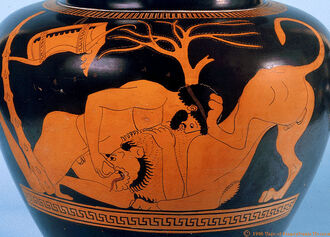
Herakles, better spelled as Heracles is the proper spelling for the Greek God Heracles. The reason for the two spellings is that the Ancient Greeks did not have the letter C for any word. The equivalent in most cases was the letter ‘K’ (kappa). Eventually this would change but some of the Ancient Greek fundamentalists spell it with a ‘K’.
His Roman counterpart is Hercules.
Personality
Herakles was considered the greatest of heroes, however his intelligence was limited to waging war, and killing beasts and monsters. Herakles relied on his strength and knowledge of weapons to defeat his enemies, rather than cunning such as Theseus, and in a later generation, Odysseus. There was only one occasion where Herakles managed to successfully use trickery on an enemy and that was merely because his enemy was Atlas, the second least intelligent Titan (the least being Epimetheus).
While Herakles was very loyal to friends, he did not forget nor forgive insults or broken promises made to him, such as when Augeas refused to pay Herakles for cleaning his stables. After the labors Herakles waged war against him.
Herakles was also harder on himself than anyone else when he made mistakes. For example, when he killed his first wife and their children due to madness brought on by Hera, his friends and the community and general recognized his actions were not his fault and he was not to blame. Herakles however thought different and became intent on performing some sort of penance. This brought about the Twelve Labors of Herakles.
Mythology
Childhood
Herakles, who was born Alkaeus, was not a normal child, even as a baby. One day, he and his brother, Iphicles, were put to sleep, Hera sent two poisonous snakes to kill Herakles (though there is a less accepted theory that his step-father Amphitryon sent them in order to find out which if either was his son). That evening the snakes came into the room where Iphicles and Herakles slept. Alcmene was awakened by screams from the children’s the room. Alcmene woke Amphitryon who promptly grabbed his sword and shield. Amphitryon and Alkemene rushed in and found Iphicles cowering in the corner crying while Herakles was gleefully shaking the dead, limp bodies of the snakes which Herakles had managed to strangle to death in the time that it had taken Amphitryon to grab a sword and shield and rush to the nursery.
Adolescence
In his youth Herakles had already made a name for himself. At some point Herakles found himself in Thespiae an ancient Greek city (Polis) in Boeotia hunting a lion (not the Nemean Lion). At the time Thespiae was ruled by King Thespius (the land’s founder) and Queen Megamede. When Thespius learned of Herakles’ presence he saw a way to take advantage of it.
The king and queen had fifty daughters (it is likely many of them were daughters of Thespias and mistresses) all of whom were of marrying age but not married. Thespius came up with the idea of having all of his daughters become pregnant by Herakles.
Thespius extended his hospitality to the great hero and invited him to stay at the palace while Herakles was hunting down the lion. Thespius said for the time that Herakles was there «you may have my eldest daughter Prokris as your bedfellow.»
Each night Thespius sent a different one of his daughters (dressed similar to how Prokris had on the first night) to be impregnated by Herakles. The combination of being tired from the hunt and each evening’s dinner meant Herakles was not able to realize he was with a different daughter. By the time Herakles finally hunted down and killed the lion and was ready to leave he had slept with forty-nine of the fifty daughters (one of them did not like her father’s plan) and the daughters bore a total of fifty-one sons (the eldest Prokris and the youngest of the daughters both bearing twins).
First Marriage
Since birth, Heracles was hunted by Hera’s fury. Her revenge came to a climax after Heracles’ marriage. One day, Hera made Heracles go into a blind frenzy, inflicting chaos on all those around him. But those people were his wife and children. After recovering from the rage, he was shocked to find his family dead at his feet. The people around could not bear the knowledge of Heracles act and told him. Crying for his loved ones, and calling himself a murderer, Theseus, king of Athens, came forth from the crowd, offered the demigod his hand and told him to come with him to Athens. At first, Heracles refused to touch the hand, since according to the Greek belief, a man who touches the blood of a murdered one is also responsible for the act. After Theseus insisted, Heracles agreed. At Athens, Heracles sought out the Oracle, which told Heracles that if he wished to be pure again, he must punish himself. Heracles left and turned to his uncle, Eurystheus, who was a cruel, insidious man. Eurystheus took the offer and gave Heracles what was later known as the Twelve Labors of Herakles.
Time as an Argonaut
Some time after completing his twelve labors Herakles took part in another famous adventure, the Quest for the Golden Fleece.
Trojan Sea Monster
The Argonauts had gotten caught in a storm
“They [the Argonauts] encountered a storm and were carried to Sigeion in the Troad. When they disembarked there, it is said, they discovered a maiden bound in chains upon the shore, the reason for it being as follows. Poseidon, as the story runs, became angry with Laomedon the king of Troy in connection with the building of its walls, according to the mythical story, and sent forth a Ketos (Sea-Monster) to ravage the land. By this monster those who made their living by the seashore and the farmers who tilled the land contiguous to the sea were being surprised and carried off. Furthermore, a pestilence fell upon the people and a total destruction of their crops, so that all the inhabitants were at their wits end because of the magnitude of what had befallen them. Consequently the common crowd gathered together into an assembly and sought for a deliverance from their misfortunes, and the king, it is said, dispatched a mission to Apollon to inquire of the god regarding what had befallen them. When the oracle, then, became known, which told that the cause was the anger of Poseidon and that only then would it cease when the Trojans should of their free will select by lot one of their children and deliver him to the monster for his food, although all the children submitted to the lot, it fell upon the king’s daughter Hesione. Consequently, Laomedon was constrained by necessity to deliver the maiden and to leave her, bound in chains, upon the shore. Here Herakles, when he had disembarked with the Argonauts and learned from the girl of her sudden change of fortune, rent asunder the chains which were about her body and going up to the city made an offer to the king to slay the Ketos. When Laomedon accepted the proposal and promised to give him as a reward his invincible mares, Herakles they say, did slay the Ketos and Hesione given the choice either to leave her home with her saviour or to remain in her native land with her parents. The girl, then chose to spend her life with the stranger, not merely because she preferred the benefaction that she had received to the ties of kinship, but also because she feared that a Ketos might again appear and she be exposed by the citizens to the same fate as that from which she had just escaped.”
Departure From the Argonauts
His time however as an Argonaut was brief, the Argonauts decided to have a competition to see who could row for the longest period of time before exhaustion set in. The last two were Jason and Herakles and finally Jason became exhausted but moments later Herakles’ oar broke.
So that Herakles could get wood for a new oar the Argonauts stopped at the island Mysia. Herakles set out to find a sturdy which Herakles could make his oar while his and his close companion Hylas went to get water. The nymph or nymphs (Pegaiai Naiades) of the local spring (Dryope in particular), fell in love with Hylas and kidnapped him thus Hylas vanished without a trace.
When Herakles noticed Hylas had disappeared he along with Polyphemus searched the island for a great length of time. The two spent so much time that under great pressure from most of the crew that Jason decided they had waited long enough for Herakles and Polyphemus. So, the crew of the Argo left without them bringing an end to Herakles’ brief time as an Argonaut.
Twelve Labors
The First Labor: Slay the Nemean Lion
The Nemean Lion known as Leon Nemeios (Λεον Νεμειος), was the son of the monster Ekhidna, it dwelled in Nemea, north of Argus. The lion was said to be bigger than Heracles, could not be harmed by any weapon. He used to emerge from two openings in his cave and destroy anything and anyone who stood in his way, and terrorized the nearby valleys. As a first task, Aristeaus told Herakles to bring him the skin of the Nemean Lion.
Herakles climbed the mountain, passed the bushes and at twilight he found the lion. Herakles took his bow and shot the lion. Since no weapons could harm it, the arrow fell to the ground as the lion did not even notice it. Heracles shot an arrow to the monster’s chest, but of no avail. But that last arrow fell between the Lion’s feet and he noticed Herakles, and jumped toward him. The demigod tried to hit its head with an olive wood branch, but it only misted the Lion’s eyes and it retreated back to its lair.
Herakles used his enemy’s blindness, and blocked the rear entrance of the cave, and stormed through the front, there he found the lion. The hero jumped on the beast’s back, and since he could not harm it with weapons, he suffocated it to death. Using the dead Lion’s own claws, he opened its body and made a mantal from the skin. He wore it ever since.
Returning with the pelt to the capital city, his uncle was so afraid of Herakles’ mighty power he ordered him to never enter the capital with the evidence of his labors, and gave his nephew tasks using a messenger.
The Second Labor: Slay the Lernean Hydra
The Lernaean Hydra (Λερναιαν Ὑδρα), yet another child of Ekhidna, was a terrifying beast, which lived near Amimona river, and bathed in the deep swamps nearby. It had nine heads of a serpent and a body of a dog. With its deadly venomous spit, it killed animals and destroyed crops. Heracles was told to slay the Hydra, and came to her home by a chariot driven by Iolaus, his nephew. The demigod fired burning arrows into its lair to call the Hyra out, but to his surprise, both the Hydra and another beast came out. It was a giant crab sent by Hera, so Heracles may find his death. Coming out of the mud, the crab bit Heracles’ leg, trying to make him fall. Heracles crushed the crab with his heel, but was trapped by the Hyra. Herakles tried to behead the Hydra, but whenever a head was cut off, two others grew instead. Seeing Heracles failing to cut off the Hydra’s heads, Iolaus burned a branch of a nearby tree, and whenever a head was chopped, he burned it so another may not grow. At the end, only one head remained, but it was immortal, so Heracles took a rock and buried the head underneath. Returning to the city, Aristaeus claimed since Herakles had Iolaus as an assistance, it was not to be considered a task.
The Third Labor: Capture the Golden Hind of Artemis
Eurystheus and Hera were greatly angered to find that Heracles had managed to escape from the claws of the Nemean Lion and the fangs of the Lernaean Hydra, and so decided to spend more time thinking up a third task that would spell doom for the hero. The third task did not involve killing a beast, as it had already been established that Heracles could overcome even the most fearsome opponents, so Eurystheus decided to make him capture the Kerynitis Hind, as it was so fast it could outrun an arrow.
After beginning the search, Heracles awoke from sleeping and he could see the hind from the glint on its antlers. Heracles then chased the hind on foot for a full year through Greece, Thrace, Istria and the land of the Hyperboreans. In some versions, he captured the hind while it slept, rendering it lame with a trap net. In other versions, he encountered Artemis in her temple and she told him to leave the hind and tell Eurystheus all that had happened and his third labor would be considered to be completed. Yet another version claims that Herakles trapped the Hind with an arrow between the forelegs of the creature.
Eurystheus had given Heracles this task hoping to incite Artemis’ anger at Heracles for his desecration of her sacred animal. As he was returning with the hind, Heracles encountered Artemis and her brother Apollo. He begged the goddess for forgiveness, explaining that he had to catch it as part of his penance, but he promised to return it. Artemis forgave him, foiling Eurystheus’ plan to have her punish him.
Upon bringing the hind to Eurystheus, he was told that it was to become part of the King’s menagerie. Heracles knew that he had to return the hind as he had promised, so he agreed to hand it over on the condition that Eurystheus himself come out and take it from him. The King came out, but the moment Heracles let the hind go, it sprinted back to its mistress, and Heracles left saying that Eurystheus had not been quick enough. Eurystheus, upset that Heracles had managed to overcome yet another creature, told him to bring the fearsome Erymanthian Boar back to him alive.
The Fourth Labor: Capture the Erymanthian Boar
For Herakles’ fourth labor, he was charged to capture the Erymanthian Boar, an enormous boar that had been a giant fear-inspiring creature of the wilds that lived on Mount Erymanthos. The Erymanthian Boar that attacked the farmlands of Psophis.
Hercules’ fourth labour—by some counts, for there is no single definitive telling—was to capture the Ermanthian Boar. On the way there, Herakles visited Pholus («caveman»), a kind and hospitable centaur and old friend. Hercules ate with him in his cavern—though the centaur devoured his meat raw—and asked for wine. Pholus had only one jar of wine, a gift from Dionysoss to all the centaurs on Mt. Erymanthos. Heracles convinced him to open it, and the smell attracted the other centaurs. They did not understand that wine needs to be tempered with water, became drunk, and attacked. Herakles shot at them with his poisonous arrows, and the centaurs retreated all the way to Khiron’s cave.
Pholus was curious why the arrows caused so much death, and picked one up but dropped it, and the arrow stabbed his foot, poisoning him. One version states that a stray arrow hit Khiron as well, but Khiron was immortal, although he still felt the pain. Khiron’s pain was so great, he volunteered to give up his immortality, and take the place of Prometheus, who had been chained in to the top of a mountain to have his liver eaten daily by an eagle, although he was an immortal Titan. Prometheus’ torturer, the eagle, continued its torture on Khiron, so Heracles shot it dead with an arrow. It is generally accepted that the tale was meant to show Heracles as being the recipient of Khiron’s surrendered immortality. However, this tale contradicts the fact that Khiron later taught Akhilles. The tale of the Kentaurs sometimes appears in other parts of the twelve labours, as does the freeing of Prometheus.
Heracles had visited Khiron to gain advice on how to catch the boar, and Chiron had told him to drive it into thick snow, which sets this Labour in mid-winter. Having successfully caught the Boar, Heracles bound it and carried it back to Eurystheus, who was frightened of it and ducked down in his half-buried storage pithos, begging Heracles to get rid of the beast, a favorite subject for the vase-painters. Heracles obliged. Roger Lancelyn Green states in his Tales of the Greek Heroes that Heracles threw it in the sea. It then swam to Italy, where its tusks were preserved in the Temple of Apollo at Cumae. Three days later, Eurystheus, still trembling with fear, sent Heracles to clean the Augean stables.
The Fifth Labor: Clean the Augean Stables
The fifth Labour of Heracles was to clean the Augean Stables. This assignment was intended to be both humiliating (rather than impressive, as had the previous labours) and impossible, since the livestock were divinely healthy (immortal) and therefore produced an enormous quantity of dung. These stables had not been cleaned in over 30 years, and over 1,000 cattle lived there. However, Heracles succeeded by rerouting the rivers Alpheus and Peneus to wash out the filth.
Augeas was irate because he had promised Heracles one tenth of his cattle if the job was finished in one day. He refused to honour the agreement, and Herakles killed him after completing the tasks. Heracles gave his kingdom to Augeas’ son Phyleus, who had been exiled for supporting Heracles against his father.
The Sixth Labor: Rid the Island Stymphalos of the Man-eating Birds
For his sixth labor, Herakles had to get rid of the Man-Eating Stymphalian Birds. Herakles traveled to the island of Stymphalos. Heracles could not go too far into the swamp, for it would not support his weight. Athena, noticing the hero’s plight, gave Heracles a set of castanets which had made especially for the occasion. Heracles shook the Castanets and frightened the birds into the air (other versions of the story say that Herakles was given a pair of symbols which he banged loudly). Heracles then shot many of them with his arrows. The rest flew far away, never to return. The Argonauts would later encounter them. Heracles then brought some of the birds he had killed to Eurystheus. He then sent Heracles to capture the Cretan Bull and bring it to him. In order to get them out of the trees Herakles first started banging cymbols.
The Seventh Labor: Capture the Kretan Bull
Whistling merrily at his success so far, Heracles was then sent to capture the bull by Eurystheus as his seventh task. He sailed to Krete, whereupon the King, Minos, gave Heracles permission to take the Kretan Bull away and offered him assistance, which Heracles denied because of pride, as it had been wreaking havoc on Krete by uprooting crops and leveling orchard walls. Heracles snuck up behind the bull and then used his hands to strangle it, and then shipped it back to Athens. Eurystheus, who hid in his pithos at first sight of the creature, wanted to sacrifice the bull to Hera, who hated Heracles. She refused the sacrifice because it reflected glory on Heracles. The bull was released and wandered into Marathon, becoming known as the Marathonian Bull. Theseus would later sacrifice the bull to Athena and/or Apollo.
The Eighth Labor: Steal the Men Eating Mares of Diomedes
After capturing the Kretan bull, Herakles was to steal the Mares of Diomedes. In one version of the story, Heracles brought a number of youths to help him. They took the mares and were chased by Diomedes and his men.
Herakles was not aware that the horses, called Podagros (the fast), Lampon (the shining), Xanthos (the blond) and Deinos (the terrible), were kept tethered to a bronze manger because they were wild; their madness being attributed to an unnatural diet of human flesh. Some versions say that they expelled fire when they breathed. They were man-eating and uncontrollable, and Herakles left his favoured companion, Abderus, in charge of them while he fought Diomedes, and found out that the boy was eaten. In revenge, Herakles fed Diomedes to his own horses, then founded Abdera next to the boy’s tomb.
In another version, Herakles stayed awake so that he didn’t have his throat cut by Diomedes in the night, and cut the chains binding the horses. Having scared the horses onto the high ground of a peninsula, Heracles quickly dug a trench through the peninsula, filling it with water, thus making it an island. When Diomedes arrived, Heracles killed him with an axe (the one used to dig the trench), and fed the body to the horses to calm them.
Both versions have eating make the horses calmer, and Herakles took the opportunity to bind their mouths shut, and easily took them back to King Eurystheus, who dedicated the horses to Hera. In some versions, they were allowed to roam freely around Argos, having become permanently calm, but in others, Eurystheus ordered the horses taken to Olympus to be sacrificed to Zeus, but Zeus refused them, and sent wolves, lions, and bears to kill them. Roger Lancelyn Green states in his Tales of the Greek Heroes that their descendants were used in the Trojan War. After the incident, Eurystheus sent Herakles to bring back the Girdle of Hippolyta.
The Ninth Labor: Obtain the Girdle of Hippolyta, Queen of the Amazons
Hippolyta appears in the myth of Heracles.He was sent to obtain the Girdle of Hippolyta It was her girdle that Heracles was sent to retrieve for Admeta, the daughter of king Eurystheus, as his ninth labor. When Heracles landed the Amazons originally were reserved and did not received him warmly. However Herakles performed a feet of great strength and won them over. Upon hearing his request, she agreed to let him take the girdle. Hera, however, was not pleased, as was often the case with Heracles. The fact that Herakles won the Amazons over so easily and thus acquired the Girdle with ease, Hera was upset. Hera took action to stop him, she came down to the Amazons disguised as one of their own and ran through the land, crying that Heracles meant to kidnap their queen. Probably remembering all too well what Theseus had done. Several of the Amazons including Aella, Alkippe, Antiope and Moldapia charged toward the ship to save Hippolyta. Fearing that Hippolyta had betrayed him, Heracles kissed her briefly then hastily killed her, Herakles ripped the girdle from her lifeless body, and set sail, narrowly escaping the raging warriors.
The Tenth Labor: Obtain the Cattle of the Giant Geryon
The tenth labour was to obtain the Cattle of Geryon. In the fullest account in the Bibliotheca of Apollodorus, Herakles had to go to the island of Erytheia in the far west (sometimes identified with the Hesperides), or with the island which forms the city of Cádiz, Spain to get the Cattle. On the way there, he crossed the Libyan dessert and became so frustrated at the heat that he shot an arrow at the sun god Helios who «in admiration of his courage» gave Hercules the golden chariot Helios used to sail across the sea from west to east each night. Hercules rode the chariot to Erytheia; Hercules in the chariot was a favorite motif on black-figure pottery. Such a magical conveyance undercuts any literal geography for Erytheia, the «red island» of the sunset.
When Hercules landed at Erytheia, he was confronted by the two-headed dog Orthrus. With one blow from his olive-wood club, Hercules killed Orthrus. Eurytion the herdsman came to assist Orthrus, but Hercules dealt with him the same way.
On hearing the commotion, Geryon sprang into action, carrying three shields and three spears, and wearing three helmets. He attacked Hercules at the River Anthemus, but was slain by one of Hercules’ poisoned arrows. Hercules shot so forcefully that the arrow pierced Geryon’s forehead, «and Geryon bent his neck over to one side, like a poppy that spoils its delicate shapes, shedding its petals all at once.» Hercules then had to herd the Cattle back to Eurystheus.
While Appollodorus does not include this in his version of the narative, while driving the herd over the Aventine Hill the giant Kakus, who lived there, stole some of the Cattle as Hercules slept. In a manner similar to Hermes theft of Cattle Kakus made the Cattle walk backwards so that they left no trail. According to some versions, Hercules drove his remaining cattle past the cave, where Kakus had hidden the stolen animals, and they began calling out to each other. In other versions, however it is generally accepted that it was Kakus’ own sister Kaka who told Hercules where Kakus and the cattle were. Hercules then killed Cacus, and set up an altar on the spot.
A couple of other details generally overlooked are that to annoy Hercules, Hera sent a to bite the cattle, irritate them, and scatter them. Hercules within a year retrieved them. Hera then sent a flood which raised the level of a river so much, Hercules could not cross with the cattle. He piled stones into the river to make the water shallower. When he finally reached the court of Eurystheus, the cattle were sacrificed to Hera.
The Eleventh Labor: Steal the Apples of the Hesperides
While the eleventh labor was not the most time consuming, it did take more adventures than the others did. The first challenge that Herakles faced was learning the location of the Apples of the Hesperides. In order to do that Herakles had to wrestle Nereus the all knowing shape shifting god. Herakles grabbed hold of Nereus and despite the various forms Nereus changed into, Herakles clung until he finally admitted defeat and provided Herakles the location of the Golden Apples.
Herakles next challenge came while making his journey, he crossed paths with the giant Antaios (son of Poseidon & Gaia) whose strength kept being renewed by his mother. each time Antaios touched the Earth. After deducing what the source of Antaios’ power was, Herakles managed to kill the giant by lifting him off the ground and crushing his rib cage.
After Antaios, Herakles traveled to Egypt which was reigned by King Busiris who like Antaios, a son of Poseidon. An oracle had advised the king that in order to end his nation’s drought he must sacrifice a stranger, it seemed to Busiris that Herakles was the perfect stranger. When Herakles presented himself to Busiris, the king’s priests began leading Herakles towards the altar realizing their intent, Herakles became enraged and in a fit of rage he killed Busiris and the priests.
Along his way to the Garden of the Hesperides, Herakles came to the Kaukasios Mountains where he found Prometheus chained. Herakles killed the Kaukasios Eagle and broke the chains binding Prometheus. To show his gratitude, Prometheus gave instructions to Herakles as how to get to the Garden. Prometheus also advised Herakles not to pick the Apples himself but to get Atlas to do that for him.
Following Prometheus’ directions, Herakles reached the Garden where he shot the dragon Ladon who guarded the apples. Next Herakles approached Atlas and agreed to temporarily hold the burden of the sky if Atlas would pick the apples for him. Atlas consented. Once he had picked the apples for Herakles Atlas changed his mind and told Herakles he would take the apples to Eurystheus himself and was going to leave Herakles to hold the sky. Herakles responded by pretending to be resigned to his fate but asked Atlas to hold the sky for a moment so he could adjust his lion pelt to act as a pad. The request seemed reasonable to Atlas who took the sky again. As soon as Atlas had taken back the sky, Herakles took the apples and began to make his way back home.
The Twelfth Labor: Capture Kerbros Hades’ Watchdog
Time In Lydia
At some point, following his twelve labors Herakles inadvertently killed Iphitus. As was his habit Herakles blamed himself more than others blamed him. The pennance was that Herakles, was, by the command of the Delphic Oracle Xenoclea, to be sold as a slave to Omphale for the period of a year. The compensation was to be paid to Eurytus (who refused to accept it). During that year, Omphale forced the great hero to dress as a woman (while she herself would wear his Nemean Lion pelt and carry his Olive Wood Club) and perform tasks that were generally viewed as those reserved for women such as weaving at a loom. Despite the fact that she humiliated him, she also forced him to be her lover and according to some versions she forced his to marry her. During his time at Lydia which may have extended beyond the year of forced servitude, Herakles would become the father by Omphale of Agelaus, Maleus & Tyrsenus as well as Akelus by Malis (one of the queen’s slave girls) and Kleodaees with an unnamed slave girl of Queen Omphale. It is however likely that this was not a real marriage and he was simply her lover for a period of time since he left Lydia while she was still around. It is however worth mentioning especially since his time dressed in women’s clothing doing tasks meant for women is a well known part of his life.
Second Marriage
Heracles was married to Deianeira. Long after their marriage, one day the centaur Nessus offered to ferry them across a wide river that they had to cross. Nessus set off with Deianeira first, but tried to abduct her. When Heracles realized the centaur’s real intention, Heracles chased after him and shot him with an arrow which was poisoned with Hydra’s blood. Before he died, Nessus told Deianeira to take some of his blood and semen and treasured it, since it was a very powerful medicine and: if she ever thought Heracles was being unfaithful, the centaur told her, the mixture would prevent him from betraying him. Deianeira kept the vial of blood and semen.
Gigantomachia
One of his last great adventures was his part in the war between the gods and Giants who were the children of Gaia and Tartaros. Many of these giants were created to oppose a specific god, some however were just there to help try and overthrow the Olympians in genreral. None of the giants (with the exception of Alkyones) could be killed be killed by a god alone and most required the combined efforts of a god and a mortal hero (the Gigante Leon who Herakles faced in singles combat was a rare exception). Since the gods could not kill the Gigantes without the help of a mortal hero, Herakles was recruited for the job, For more on this see
Many years after that incident she heard rumors that Heracles had fallen in love with another woman. She smeared some of the mixture on a robe and sent it to Heracles by a servant named Leechas. When doing so, some of the mixture was spilled on the floor and when the sun rays fell on it, it begun to burn. Because of this Deianeira begun to suspect Nessus’s advice and decided to send another servant to fetch Leechas back before he could hand over the soaked robe to Heracles. She was too late. Heracles has already put on the robe and when he did so the blood still poisoned from the same arrow used by Hercules, burnt into his flesh. When he jumped into a nearby river in hope of extinguishing the fire, it only made it worse. When he tried to rip off the robe from his body his organs were also ripped off with it.
Furiously, Heracles caught Leechas and tossed him into the sea. After that he told his friend Philoctetis to build him a pyre on the mountain Oata. He was burnt to death on the pyre. Before dying, Heracles offered his bow and arrows as a token of gratitude to Philoctetis. His father Zeus then turned him into a god. Deianeira, after hearing what she had caused, committed suicide.
After his death, Heracles was brought to Mt. Olympus and made a god (God of Physical Strength). At this point Hera finally overcame her jealousy and offered Heracles her daughter Hebe’s hand in marriage. He had two children.
Trivia
- Despite modern opinions/depictions, Heracles (Or Hercules) was actually not extremely muscular, in fact compared to his modern depictions he was rather scrawny. In the myths his only feature that was described as being above average was his height (four cubits/6 foot), as his strength was explained as being caused by Hera’s temporary nursing of him as a baby. Vase and mural depictions show that he was no more muscular than any of the other Greeks.
- In fact in some stories (Most notably the story of Omphale) Heracles could easily be mistaken for a girl, especially after being forced to wear the attire of a woman. This means that he was possibly androgynous in appearance.
- In works of art Heracles is depicted with the ancient ideal appearance for a man, with full, well knit, and muscular limbs, serious expression, a curling beard, short neck, and a head small in proportion to the limbs. His equipment is generally the club and the lion’s skin. The type appears to have been mainly fixed by Lysippus. The Farnese Hercules, by the Athenian Glycon, is probably a copy of one by Lysippus. Heracles is portrayed in repose, leaning on his club, which is covered with the lion’s skin.
- Among thousands of depictions of Heracles on Archaic vases there is a group of almost 40 vases datable between 530 and 500 B.C, upon which the hero appears not as a symbol known to everyone for his athletic spirit, but as «Heracles Mousikos» a musician performing on a kithara or, less frequently, on a lyre or aulos (pipes). These images show Heracles serenely accompanying his own singing to the lyre or kithara. Heracles’ music-making portrays him as well-educated, appreciative of the «finer things,» hardly a mere thug or arrogant athlete.
- According to Diodorus (4.14.1–2), one of the labors of Heracles was to found the Olympic Games, and to win every event in their first edition. This is only one of several myths about the founding of the Olympic Games, but it is a handy illustration of the perceived link between a hero’s labors and an athlete’s contests.
- Despite being frequently depicted with a club, Heracles’ primary weapon was the bow, which is interesting considering the fact that the Greeks normally scorned the bow-and-arrows as being the weapon of cowards.
Parents
- Alkmene (mother) & Zeus (father)
- Amphitryon (step-father)
Spouse & Lovers
- Megara (Herakles’s first wife who was the daughter of King Kreon of Thebes)
- Deianeira (Herakles’ second wife who was the daughter of King Oeneus of Kalydon)
- Hebe (Herakles’ third wife Hebe goddess of youth)
- Aeskhreis (a daughter of King Thespius of Thespia)
- Aglaia (a daughter of King Thespius of Thespia)
- Anthaeia (a daughter of King Thespius of Thespia)
- Anthippe (a daughter of King Thespius of Thespia)
- Antiope (a daughter of King Thespius of Thespia)
- Argele (a daughter of King Thespius of Thespia)
- Asopis (a daughter of King Thespius of Thespia)
- Astydameia (daughter of Ormenius)
- Astyokhe (daughter of Phylas)
- Auge (sister of King Kepheus of Tegea)
- Bargases
- Bolbe (An Okeanid)
- Celtine (daughter of Bretannus king of the Celts)
- Dyna
- Dynaste
- Elakhia (a daughter of King Thespius of Thespia)
- Eone (a daughter ofKing Thespius of Thespia)
- Epikaste (daughter of Augeus)
- Epilais (a daughter of King Thespius of Thespia)
- Erato (a daughter of King Thespius of Thespia)
- Euboea (a daughter of King Thespius of Thespia)
- Eubote (a daughter of King Thespius of Thespia)
- Eurybia (a daughter of King Thespius of Thespia)
- Euryke (a daughter of King Thespius of Thespia)
- Eurypyle (a daughter of King Thespius of Thespia)
- Eurytele (a daughter of King Thespius of Thespia)
- Exole (a daughter of King Thespius of Thespia)
- Helikonis (a daughter of King Thespius of Thespia)
- Hesikhaeia (a daughter of King Thespius of Thespia)
- Hippokrate (a daughter of King Thespius of Thespia)
- Hippo (a daughter of King Thespius of Thespia)
- Iphinoe (daughter of Antaios)
- Iphis (a daughter of King Thespius of Thespia)
- Kabeira (a Nymph)
- Kalametis (a daughter of King Thespius of Thespia)
- Kerthe (a daughter of King Thespius of Thespia)
- Khalkiope (daughter of King Eurypylus)
- Khania (a Nymph)
- Khryseis (a daughter of King Thespius of Thespia)
- Klytippe (a daughter of King Thespius of Thespia)
- Laothoe (a daughter of King Thespius of Thespia)
- Lavinia (a daughter of Evander)
- Lyse (a daughter ofKing Thespius of Thespia)
- Lysidike (a daughter of King Thespius of Thespia)
- Lysippe (a daughter of King Thespius of Thespia)
- Malis (a slave of Queen Omphale)
- Marse (a daughter of King Thespius of Thespia)
- Meda (daughter of King Phylas)
- Meline (a daughter of King Thespius of Thespia)
- Melite (a Naiad)
- Menippis (a daughter of King Thespius of Thespia)
- Myrto (daughter of Menoeteus)
- Nike (a daughter of King Thespius of Thespia)
- Nikippe (a daughter of King Thespius of Thespia)
- Olympusa (a daughter of King Thespius of Thespia)
- Queen Omphale (Queen of Lydia)
- Oreia (a daughter of King Thespius of Thespia)
- Palantho of Hyperborea)
- Palantia (daughter of Evander)
- Panope (daughter of King Thespius of Thespia)
- Parthenope (a daughter of Stymphalus)
- Patro (a daughter of King Thespius of Thespia)
- Philo (daughter of Alkimedon)
- Phyleis (a daughter of King Thespius of Thespia)
- Praxithea (a daughter of King Thespius of Thespia)
- Prokris (a daughter of King Thespius of Thespia)
- Psophis (a daughter of Xanthus or Eryx)
- Pyrene (daughter of King Bebrykius)
- Pyrippe (a daughter of King Thespius of Thespia)
- Rhea (an Italian priestess)
- Skythian Drakaena (She became by Herakles the mother of Agathyrsus, Gelonus and Skythes)
- Stratonike (a daughter of King Thespius of Thespia)
- Terpsikrate (a daughter of King Thespius of Thespia)
- Thebe
- Tinjis (the wife of Antaios)
- Tiphyse (a daughter of King Thespius of Thespia)
- Toxikrate (a daughter of King Thespius of Thespia)
- Unknown Consort (She became by Herakles the mother of Agamedas)
- Unknown Consort (She became by Herakles the mother of Agylleus)
- Unknown Consort (She became by Herakles the mother of Amathes, Boeus of Bretius and Brettus)
- Unknown Consort (She became by Herakles the mother of Amathous)
- Unknown Consort (She became by Herakles the mother of Azon)
- Unknown Consort (She became by Herakles the mother of Dexamenus)
- Unknown Consort (She became by Herakles the mother of Khromis)
- Unknown Consort (She became by Herakles the mother of Kyrnus)
- Unknown Consort (She became by Herakles the mother of Leukites)
- Unknown Consort (She became by Herakles the mother of Manto)
- Unknown Consort (She became by Herakles the mother of Pandaie)
- Unknown Consort (She became by Herakles the mother of Rhopalus)
- Unnamed Daughter of Thespius
- Unnamed Slave of Queen Omphale’s (She became by Herakles the mother of Kleodaees)
- Xanthis (a daughter of King Thespius of Thespia)
Male Lovers
- Abderus
- Admetus
- Adonis
- Akhaea
- Diomus
- Elakatas
- Hylas
- Iolaus
- Iphitus
- Korythus
- Nestor
- Nireus
- Perithoas
- Philoctetes
- Phrix
- Polystratus
- Sostratus
Children
- Akelus (by Malis, a slave of Queen Omphale)
- Aekhmagoras (by Philo daughter of Alkimedon)
- Agamedas (with an unknown woman)
- Agathyrsus (with the Skythian Drakaina)
- Agelaus (with Queen Omphale the Queen of Lydia)
- Agylleus (with an unknown consort)
- Alexiares (by Hebe with Herakles’ third wife Hebe goddess of youth)
- Alopius (with Antiope a daughter of King Thespius)
- Amathes (with unknown woman who is also the mother of Boeus of Bretius and Brettus)
- Amathous (with an unknown consort)
- Amestrius (with Eone a daughter of King Thespius)
- Aniketos (with Herakles’ third wife Hebe goddess of youth)
- Antiades (with Aglaia a daughter of King Thespius)
- Antileon (with Prokris a daughter of King Thespius)
- Antimakhus (with Nikippe a daughter of King Thespius)
- Antiokhus (with Anthaeia daughter of King Thespius)
- Antiokhus (with Meda daughter of King Phylas)
- Antiphus (with Laothoe a daughter of King Thespius)
- Arkhedikus (with Eurypyle a daughter of King Thespius)
- Arkhimakhus (with Patro a daughter of King Thespius
- Astromus (with Stratonike a daughter of King Thespius)
- Astyanax (with Epilais a daughter of King Thespius)
- Astybies (with Kalametis a daughter of King Thespius)
- Aventinus (with Rhea, an Italian priestess)
- Azon (with an unknown consort)
- Barge (with Bargases)
- Bokolus (with Marse a daughter of King Thespius)
- Boeus (with unknown woman who is also the mother of Bretius, Brettus and Amathes)
- Bretius (with unknown woman, who is also the mother of Brettus, Boeus and Amathes)
- Brettus (with unknown woman, who is also the mother of Bretius, Boeus and Amathes)
- Buleus (with Elakhia a daughter of King Thespius)
- Celtus (with Celtine daughter of Bretannus king of the Celts)
- Deikoon (with Herakles’ first wife Megara a daughter of King Kreon of Thebes)
- Dexamenus (with an unknown consort)
- Dynastes (with Erato a daughter of King Thespius)
- Ekhephron (with Psophis a daughter of Xanthus or Eryx)
- Entelades (with Menippis a daughter of King Thespius)
- Erasippus (with Lysippe a daughter of King Thespius)
- Eratus (with Dynaste)
- Eukleia-(with Myrto daughter of Menoeteus)
- Eumedes (with Lyse a daughter of King Thespius)
- Eurykapys (with Klytippe a daughter of King Thespius)
- Euryopes (with Terpsikrate a daughter of King Thespius)
- Eurypyles (with Eubote a daughter of King Thespius)
- Eurythrus (with Exole a daughter of King Thespius)
- Everus (with Parthenope daughter of Stymphalus)
- Glenos (with Herakles’ second wife Deianeira daughter of King Oeneus of Kalydon)
- Gelon (with Khania, a nymph)
- Gelonus (with the Skythian Drakaina)
- Halokrates (with Olympusa a daughter of King Thespius)
- Hippeus (with Prokris a daughter of King Thespius)
- Hippodamus (with Anthippe a daughter of King Thespius)
- Hippozygus (with Hippokrate a daughter of King Thespius)
- Homolippus (with Xanthis a daughter of King Thespius)
- Hyllus (with Herakles’ second wife Deianeira daughter of King Oeneus of Kalydon)
- Hyllus (with a naiad Melite)
- Iobes (with Kerthe a daughter of King Thespius)
- Kadmillus (with a nymph named Kabeira)
- Kapylus (with Hippo a daughter of King Thespius)
- Keleustinor (with Iphis a daughter of King Thespius)
- Khromis (with an unknown consort)
- Kleolaus (with Argele a daughter of King Thespius)
- Kleodaees (with one of Queen Omphale’s slave girls)
- Kreon (with One of the daughters of King Thespius possibly Argele)
- Kreontiades (with Herakles’ first wife Megara a daughter of King Kreon of Thebes)
- Ktesippus (with Herakles’ second wife Deianeira daughter of King Oeneus of Calydon)
- Ktesippus (with Astydameia, daughter of Ormenius)
- Kyrnus (with an unknown consort)
- Laomedon (with Meline a daughter of King Thespius)
- Laomenes (with Oreia a daughter of King Thespius)
- Latinus (with Palantho of Hyperborea)
- Leukippus (with Eurytelle a daughter of King Thespius)
- Leukites (with an unknown consort)
- Leukoneus (with Aeskhreis a daughter of King Thespius)
- Lykurgus. (with Toxikrate (a daughter of King Thespius)
- Lynkaeus (with Tiphyse a daughter of King Thespius)
- Makaria (with Herakles’ second wife Deianeira daughter of King Oeneus of Kalydon)
- Maleus (with Queen Omphale Queen of Lydia)
- Manto (with an unknown consort)
- Mentor (with Asopis a daughter of King Thespius)
- Nephus (with Praxitheia a daughter of King Thespius)
- Nikodromus (with Nike a daughter of King Thespius)
- Oenites (with Herakles’ second wife Deianeira daughter of King Oeneus of Kalydon)
- Oestrobleus (with Hesikhaeia a daughter of King Thespius)
- Olynthus (with Bolbe)
- Olympusa (with Euboea a daughter of King Thespius)
- Onesippus (with Khryseis a daughter of King Thespius)
- Palaemon (with Iphinoe daughter of Antaeus)
- Pallas (with Dyna)
- Pallas (with Lavinia, daughter of Evander)
- Pandaie (with an unknown Indian consort)
- Patroklus (with Pyrippe a daughter of King Thespius)
- Phalius (with Helikonis a daughter of King Thespius)
- Polylaus (with Eurybia a daughter of King Thespius)
- Promakhus (with Prophis a daughter of Xanthus or Eryx)
- Rhopalus (with unknown woman)
- Skythes (with the Skythian Drakaina)
- Sophax (with Tinge, wife of Antaeus)
- Telephus (with Auge sister of Kepheus of King Tegea)
- Teles (with Lysidike a daughter of King Thespius)
- Teleutagoras (with Euryke a daughter of King Thespius)
- Therimakhus (with Herakles’ first wife Megara a daughter of King Kreon of Thebes)
- Threpsippas (with Panope a daughter of King Thespius)
- Thestalus (with Epikaste the daughter of Augeus)
- Thettalus (with Khalkiope daughter of Eurypylus)
- Tigasis (with Phyleis a daughter of King Thespius)
- Tlepolemus (with Astyokhe daughter of Phylas)
- Unknown Son (with Palantia daughter of Evander)
- Unnamed Serpent
- Unnamed Twin Son (Son of one of the daughters of Thespius)
12 Labors Gallery
Close-up of Herakles and the Nemean Lion. On Attic Black-Figure column krater circa 550-540
Herakles Choking The Nemean Lion
Herakles facing the Lernean Hydra (Gustave Moreau, 1876)
Herakles fighting the Lernaean Hydra
Herakles killing the Hydra
Bull
Partial of mosaic showing Herakles’ Ninth Labor
Herakles fighting an Amazon.
Hippolyta dying in Herakles arms as he prepares to leave with her belt
Heracles and Ladon, Roman relief plate, late era.
Herakles holding the burden of the sky so Atlas could pick the Apples of The Hesperides
Gallery of Herakles in his various adventures
Herakles shooting Nessos who attempts to abduct Deianeira
Herakles & Deianeira
Herakles wrestling Nereus
Attic Red-Figure circa 470 BCE. depicting Herakles fighting with King Busiris of Egypt
Red-Figure column-krater circa 470 BCE. depicting Herakles fighting with King Busiris of Egypt
Herakles using his club on Geras
Herakles in the cave of the Centaur Pholos. A White-Ground lekythos circa 480 BCE.
Herakles wrestles Thanatos
Herakles and Megara (with one of their sons)
Gigantomachy
A depiction of the Gigantomachy showing a typical central group of Zeus, Heracles and Athena. black-figure amphora c. 530-520 BC

Herakles, better spelled as Heracles is the proper spelling for the Greek God Heracles. The reason for the two spellings is that the Ancient Greeks did not have the letter C for any word. The equivalent in most cases was the letter ‘K’ (kappa). Eventually this would change but some of the Ancient Greek fundamentalists spell it with a ‘K’.
His Roman counterpart is Hercules.
Personality
Herakles was considered the greatest of heroes, however his intelligence was limited to waging war, and killing beasts and monsters. Herakles relied on his strength and knowledge of weapons to defeat his enemies, rather than cunning such as Theseus, and in a later generation, Odysseus. There was only one occasion where Herakles managed to successfully use trickery on an enemy and that was merely because his enemy was Atlas, the second least intelligent Titan (the least being Epimetheus).
While Herakles was very loyal to friends, he did not forget nor forgive insults or broken promises made to him, such as when Augeas refused to pay Herakles for cleaning his stables. After the labors Herakles waged war against him.
Herakles was also harder on himself than anyone else when he made mistakes. For example, when he killed his first wife and their children due to madness brought on by Hera, his friends and the community and general recognized his actions were not his fault and he was not to blame. Herakles however thought different and became intent on performing some sort of penance. This brought about the Twelve Labors of Herakles.
Mythology
Childhood
Herakles, who was born Alkaeus, was not a normal child, even as a baby. One day, he and his brother, Iphicles, were put to sleep, Hera sent two poisonous snakes to kill Herakles (though there is a less accepted theory that his step-father Amphitryon sent them in order to find out which if either was his son). That evening the snakes came into the room where Iphicles and Herakles slept. Alcmene was awakened by screams from the children’s the room. Alcmene woke Amphitryon who promptly grabbed his sword and shield. Amphitryon and Alkemene rushed in and found Iphicles cowering in the corner crying while Herakles was gleefully shaking the dead, limp bodies of the snakes which Herakles had managed to strangle to death in the time that it had taken Amphitryon to grab a sword and shield and rush to the nursery.
Adolescence
In his youth Herakles had already made a name for himself. At some point Herakles found himself in Thespiae an ancient Greek city (Polis) in Boeotia hunting a lion (not the Nemean Lion). At the time Thespiae was ruled by King Thespius (the land’s founder) and Queen Megamede. When Thespius learned of Herakles’ presence he saw a way to take advantage of it.
The king and queen had fifty daughters (it is likely many of them were daughters of Thespias and mistresses) all of whom were of marrying age but not married. Thespius came up with the idea of having all of his daughters become pregnant by Herakles.
Thespius extended his hospitality to the great hero and invited him to stay at the palace while Herakles was hunting down the lion. Thespius said for the time that Herakles was there «you may have my eldest daughter Prokris as your bedfellow.»
Each night Thespius sent a different one of his daughters (dressed similar to how Prokris had on the first night) to be impregnated by Herakles. The combination of being tired from the hunt and each evening’s dinner meant Herakles was not able to realize he was with a different daughter. By the time Herakles finally hunted down and killed the lion and was ready to leave he had slept with forty-nine of the fifty daughters (one of them did not like her father’s plan) and the daughters bore a total of fifty-one sons (the eldest Prokris and the youngest of the daughters both bearing twins).
First Marriage
Since birth, Heracles was hunted by Hera’s fury. Her revenge came to a climax after Heracles’ marriage. One day, Hera made Heracles go into a blind frenzy, inflicting chaos on all those around him. But those people were his wife and children. After recovering from the rage, he was shocked to find his family dead at his feet. The people around could not bear the knowledge of Heracles act and told him. Crying for his loved ones, and calling himself a murderer, Theseus, king of Athens, came forth from the crowd, offered the demigod his hand and told him to come with him to Athens. At first, Heracles refused to touch the hand, since according to the Greek belief, a man who touches the blood of a murdered one is also responsible for the act. After Theseus insisted, Heracles agreed. At Athens, Heracles sought out the Oracle, which told Heracles that if he wished to be pure again, he must punish himself. Heracles left and turned to his uncle, Eurystheus, who was a cruel, insidious man. Eurystheus took the offer and gave Heracles what was later known as the Twelve Labors of Herakles.
Time as an Argonaut
Some time after completing his twelve labors Herakles took part in another famous adventure, the Quest for the Golden Fleece.
Trojan Sea Monster
The Argonauts had gotten caught in a storm
“They [the Argonauts] encountered a storm and were carried to Sigeion in the Troad. When they disembarked there, it is said, they discovered a maiden bound in chains upon the shore, the reason for it being as follows. Poseidon, as the story runs, became angry with Laomedon the king of Troy in connection with the building of its walls, according to the mythical story, and sent forth a Ketos (Sea-Monster) to ravage the land. By this monster those who made their living by the seashore and the farmers who tilled the land contiguous to the sea were being surprised and carried off. Furthermore, a pestilence fell upon the people and a total destruction of their crops, so that all the inhabitants were at their wits end because of the magnitude of what had befallen them. Consequently the common crowd gathered together into an assembly and sought for a deliverance from their misfortunes, and the king, it is said, dispatched a mission to Apollon to inquire of the god regarding what had befallen them. When the oracle, then, became known, which told that the cause was the anger of Poseidon and that only then would it cease when the Trojans should of their free will select by lot one of their children and deliver him to the monster for his food, although all the children submitted to the lot, it fell upon the king’s daughter Hesione. Consequently, Laomedon was constrained by necessity to deliver the maiden and to leave her, bound in chains, upon the shore. Here Herakles, when he had disembarked with the Argonauts and learned from the girl of her sudden change of fortune, rent asunder the chains which were about her body and going up to the city made an offer to the king to slay the Ketos. When Laomedon accepted the proposal and promised to give him as a reward his invincible mares, Herakles they say, did slay the Ketos and Hesione given the choice either to leave her home with her saviour or to remain in her native land with her parents. The girl, then chose to spend her life with the stranger, not merely because she preferred the benefaction that she had received to the ties of kinship, but also because she feared that a Ketos might again appear and she be exposed by the citizens to the same fate as that from which she had just escaped.”
Departure From the Argonauts
His time however as an Argonaut was brief, the Argonauts decided to have a competition to see who could row for the longest period of time before exhaustion set in. The last two were Jason and Herakles and finally Jason became exhausted but moments later Herakles’ oar broke.
So that Herakles could get wood for a new oar the Argonauts stopped at the island Mysia. Herakles set out to find a sturdy which Herakles could make his oar while his and his close companion Hylas went to get water. The nymph or nymphs (Pegaiai Naiades) of the local spring (Dryope in particular), fell in love with Hylas and kidnapped him thus Hylas vanished without a trace.
When Herakles noticed Hylas had disappeared he along with Polyphemus searched the island for a great length of time. The two spent so much time that under great pressure from most of the crew that Jason decided they had waited long enough for Herakles and Polyphemus. So, the crew of the Argo left without them bringing an end to Herakles’ brief time as an Argonaut.
Twelve Labors
The First Labor: Slay the Nemean Lion
The Nemean Lion known as Leon Nemeios (Λεον Νεμειος), was the son of the monster Ekhidna, it dwelled in Nemea, north of Argus. The lion was said to be bigger than Heracles, could not be harmed by any weapon. He used to emerge from two openings in his cave and destroy anything and anyone who stood in his way, and terrorized the nearby valleys. As a first task, Aristeaus told Herakles to bring him the skin of the Nemean Lion.
Herakles climbed the mountain, passed the bushes and at twilight he found the lion. Herakles took his bow and shot the lion. Since no weapons could harm it, the arrow fell to the ground as the lion did not even notice it. Heracles shot an arrow to the monster’s chest, but of no avail. But that last arrow fell between the Lion’s feet and he noticed Herakles, and jumped toward him. The demigod tried to hit its head with an olive wood branch, but it only misted the Lion’s eyes and it retreated back to its lair.
Herakles used his enemy’s blindness, and blocked the rear entrance of the cave, and stormed through the front, there he found the lion. The hero jumped on the beast’s back, and since he could not harm it with weapons, he suffocated it to death. Using the dead Lion’s own claws, he opened its body and made a mantal from the skin. He wore it ever since.
Returning with the pelt to the capital city, his uncle was so afraid of Herakles’ mighty power he ordered him to never enter the capital with the evidence of his labors, and gave his nephew tasks using a messenger.
The Second Labor: Slay the Lernean Hydra
The Lernaean Hydra (Λερναιαν Ὑδρα), yet another child of Ekhidna, was a terrifying beast, which lived near Amimona river, and bathed in the deep swamps nearby. It had nine heads of a serpent and a body of a dog. With its deadly venomous spit, it killed animals and destroyed crops. Heracles was told to slay the Hydra, and came to her home by a chariot driven by Iolaus, his nephew. The demigod fired burning arrows into its lair to call the Hyra out, but to his surprise, both the Hydra and another beast came out. It was a giant crab sent by Hera, so Heracles may find his death. Coming out of the mud, the crab bit Heracles’ leg, trying to make him fall. Heracles crushed the crab with his heel, but was trapped by the Hyra. Herakles tried to behead the Hydra, but whenever a head was cut off, two others grew instead. Seeing Heracles failing to cut off the Hydra’s heads, Iolaus burned a branch of a nearby tree, and whenever a head was chopped, he burned it so another may not grow. At the end, only one head remained, but it was immortal, so Heracles took a rock and buried the head underneath. Returning to the city, Aristaeus claimed since Herakles had Iolaus as an assistance, it was not to be considered a task.
The Third Labor: Capture the Golden Hind of Artemis
Eurystheus and Hera were greatly angered to find that Heracles had managed to escape from the claws of the Nemean Lion and the fangs of the Lernaean Hydra, and so decided to spend more time thinking up a third task that would spell doom for the hero. The third task did not involve killing a beast, as it had already been established that Heracles could overcome even the most fearsome opponents, so Eurystheus decided to make him capture the Kerynitis Hind, as it was so fast it could outrun an arrow.
After beginning the search, Heracles awoke from sleeping and he could see the hind from the glint on its antlers. Heracles then chased the hind on foot for a full year through Greece, Thrace, Istria and the land of the Hyperboreans. In some versions, he captured the hind while it slept, rendering it lame with a trap net. In other versions, he encountered Artemis in her temple and she told him to leave the hind and tell Eurystheus all that had happened and his third labor would be considered to be completed. Yet another version claims that Herakles trapped the Hind with an arrow between the forelegs of the creature.
Eurystheus had given Heracles this task hoping to incite Artemis’ anger at Heracles for his desecration of her sacred animal. As he was returning with the hind, Heracles encountered Artemis and her brother Apollo. He begged the goddess for forgiveness, explaining that he had to catch it as part of his penance, but he promised to return it. Artemis forgave him, foiling Eurystheus’ plan to have her punish him.
Upon bringing the hind to Eurystheus, he was told that it was to become part of the King’s menagerie. Heracles knew that he had to return the hind as he had promised, so he agreed to hand it over on the condition that Eurystheus himself come out and take it from him. The King came out, but the moment Heracles let the hind go, it sprinted back to its mistress, and Heracles left saying that Eurystheus had not been quick enough. Eurystheus, upset that Heracles had managed to overcome yet another creature, told him to bring the fearsome Erymanthian Boar back to him alive.
The Fourth Labor: Capture the Erymanthian Boar
For Herakles’ fourth labor, he was charged to capture the Erymanthian Boar, an enormous boar that had been a giant fear-inspiring creature of the wilds that lived on Mount Erymanthos. The Erymanthian Boar that attacked the farmlands of Psophis.
Hercules’ fourth labour—by some counts, for there is no single definitive telling—was to capture the Ermanthian Boar. On the way there, Herakles visited Pholus («caveman»), a kind and hospitable centaur and old friend. Hercules ate with him in his cavern—though the centaur devoured his meat raw—and asked for wine. Pholus had only one jar of wine, a gift from Dionysoss to all the centaurs on Mt. Erymanthos. Heracles convinced him to open it, and the smell attracted the other centaurs. They did not understand that wine needs to be tempered with water, became drunk, and attacked. Herakles shot at them with his poisonous arrows, and the centaurs retreated all the way to Khiron’s cave.
Pholus was curious why the arrows caused so much death, and picked one up but dropped it, and the arrow stabbed his foot, poisoning him. One version states that a stray arrow hit Khiron as well, but Khiron was immortal, although he still felt the pain. Khiron’s pain was so great, he volunteered to give up his immortality, and take the place of Prometheus, who had been chained in to the top of a mountain to have his liver eaten daily by an eagle, although he was an immortal Titan. Prometheus’ torturer, the eagle, continued its torture on Khiron, so Heracles shot it dead with an arrow. It is generally accepted that the tale was meant to show Heracles as being the recipient of Khiron’s surrendered immortality. However, this tale contradicts the fact that Khiron later taught Akhilles. The tale of the Kentaurs sometimes appears in other parts of the twelve labours, as does the freeing of Prometheus.
Heracles had visited Khiron to gain advice on how to catch the boar, and Chiron had told him to drive it into thick snow, which sets this Labour in mid-winter. Having successfully caught the Boar, Heracles bound it and carried it back to Eurystheus, who was frightened of it and ducked down in his half-buried storage pithos, begging Heracles to get rid of the beast, a favorite subject for the vase-painters. Heracles obliged. Roger Lancelyn Green states in his Tales of the Greek Heroes that Heracles threw it in the sea. It then swam to Italy, where its tusks were preserved in the Temple of Apollo at Cumae. Three days later, Eurystheus, still trembling with fear, sent Heracles to clean the Augean stables.
The Fifth Labor: Clean the Augean Stables
The fifth Labour of Heracles was to clean the Augean Stables. This assignment was intended to be both humiliating (rather than impressive, as had the previous labours) and impossible, since the livestock were divinely healthy (immortal) and therefore produced an enormous quantity of dung. These stables had not been cleaned in over 30 years, and over 1,000 cattle lived there. However, Heracles succeeded by rerouting the rivers Alpheus and Peneus to wash out the filth.
Augeas was irate because he had promised Heracles one tenth of his cattle if the job was finished in one day. He refused to honour the agreement, and Herakles killed him after completing the tasks. Heracles gave his kingdom to Augeas’ son Phyleus, who had been exiled for supporting Heracles against his father.
The Sixth Labor: Rid the Island Stymphalos of the Man-eating Birds
For his sixth labor, Herakles had to get rid of the Man-Eating Stymphalian Birds. Herakles traveled to the island of Stymphalos. Heracles could not go too far into the swamp, for it would not support his weight. Athena, noticing the hero’s plight, gave Heracles a set of castanets which had made especially for the occasion. Heracles shook the Castanets and frightened the birds into the air (other versions of the story say that Herakles was given a pair of symbols which he banged loudly). Heracles then shot many of them with his arrows. The rest flew far away, never to return. The Argonauts would later encounter them. Heracles then brought some of the birds he had killed to Eurystheus. He then sent Heracles to capture the Cretan Bull and bring it to him. In order to get them out of the trees Herakles first started banging cymbols.
The Seventh Labor: Capture the Kretan Bull
Whistling merrily at his success so far, Heracles was then sent to capture the bull by Eurystheus as his seventh task. He sailed to Krete, whereupon the King, Minos, gave Heracles permission to take the Kretan Bull away and offered him assistance, which Heracles denied because of pride, as it had been wreaking havoc on Krete by uprooting crops and leveling orchard walls. Heracles snuck up behind the bull and then used his hands to strangle it, and then shipped it back to Athens. Eurystheus, who hid in his pithos at first sight of the creature, wanted to sacrifice the bull to Hera, who hated Heracles. She refused the sacrifice because it reflected glory on Heracles. The bull was released and wandered into Marathon, becoming known as the Marathonian Bull. Theseus would later sacrifice the bull to Athena and/or Apollo.
The Eighth Labor: Steal the Men Eating Mares of Diomedes
After capturing the Kretan bull, Herakles was to steal the Mares of Diomedes. In one version of the story, Heracles brought a number of youths to help him. They took the mares and were chased by Diomedes and his men.
Herakles was not aware that the horses, called Podagros (the fast), Lampon (the shining), Xanthos (the blond) and Deinos (the terrible), were kept tethered to a bronze manger because they were wild; their madness being attributed to an unnatural diet of human flesh. Some versions say that they expelled fire when they breathed. They were man-eating and uncontrollable, and Herakles left his favoured companion, Abderus, in charge of them while he fought Diomedes, and found out that the boy was eaten. In revenge, Herakles fed Diomedes to his own horses, then founded Abdera next to the boy’s tomb.
In another version, Herakles stayed awake so that he didn’t have his throat cut by Diomedes in the night, and cut the chains binding the horses. Having scared the horses onto the high ground of a peninsula, Heracles quickly dug a trench through the peninsula, filling it with water, thus making it an island. When Diomedes arrived, Heracles killed him with an axe (the one used to dig the trench), and fed the body to the horses to calm them.
Both versions have eating make the horses calmer, and Herakles took the opportunity to bind their mouths shut, and easily took them back to King Eurystheus, who dedicated the horses to Hera. In some versions, they were allowed to roam freely around Argos, having become permanently calm, but in others, Eurystheus ordered the horses taken to Olympus to be sacrificed to Zeus, but Zeus refused them, and sent wolves, lions, and bears to kill them. Roger Lancelyn Green states in his Tales of the Greek Heroes that their descendants were used in the Trojan War. After the incident, Eurystheus sent Herakles to bring back the Girdle of Hippolyta.
The Ninth Labor: Obtain the Girdle of Hippolyta, Queen of the Amazons
Hippolyta appears in the myth of Heracles.He was sent to obtain the Girdle of Hippolyta It was her girdle that Heracles was sent to retrieve for Admeta, the daughter of king Eurystheus, as his ninth labor. When Heracles landed the Amazons originally were reserved and did not received him warmly. However Herakles performed a feet of great strength and won them over. Upon hearing his request, she agreed to let him take the girdle. Hera, however, was not pleased, as was often the case with Heracles. The fact that Herakles won the Amazons over so easily and thus acquired the Girdle with ease, Hera was upset. Hera took action to stop him, she came down to the Amazons disguised as one of their own and ran through the land, crying that Heracles meant to kidnap their queen. Probably remembering all too well what Theseus had done. Several of the Amazons including Aella, Alkippe, Antiope and Moldapia charged toward the ship to save Hippolyta. Fearing that Hippolyta had betrayed him, Heracles kissed her briefly then hastily killed her, Herakles ripped the girdle from her lifeless body, and set sail, narrowly escaping the raging warriors.
The Tenth Labor: Obtain the Cattle of the Giant Geryon
The tenth labour was to obtain the Cattle of Geryon. In the fullest account in the Bibliotheca of Apollodorus, Herakles had to go to the island of Erytheia in the far west (sometimes identified with the Hesperides), or with the island which forms the city of Cádiz, Spain to get the Cattle. On the way there, he crossed the Libyan dessert and became so frustrated at the heat that he shot an arrow at the sun god Helios who «in admiration of his courage» gave Hercules the golden chariot Helios used to sail across the sea from west to east each night. Hercules rode the chariot to Erytheia; Hercules in the chariot was a favorite motif on black-figure pottery. Such a magical conveyance undercuts any literal geography for Erytheia, the «red island» of the sunset.
When Hercules landed at Erytheia, he was confronted by the two-headed dog Orthrus. With one blow from his olive-wood club, Hercules killed Orthrus. Eurytion the herdsman came to assist Orthrus, but Hercules dealt with him the same way.
On hearing the commotion, Geryon sprang into action, carrying three shields and three spears, and wearing three helmets. He attacked Hercules at the River Anthemus, but was slain by one of Hercules’ poisoned arrows. Hercules shot so forcefully that the arrow pierced Geryon’s forehead, «and Geryon bent his neck over to one side, like a poppy that spoils its delicate shapes, shedding its petals all at once.» Hercules then had to herd the Cattle back to Eurystheus.
While Appollodorus does not include this in his version of the narative, while driving the herd over the Aventine Hill the giant Kakus, who lived there, stole some of the Cattle as Hercules slept. In a manner similar to Hermes theft of Cattle Kakus made the Cattle walk backwards so that they left no trail. According to some versions, Hercules drove his remaining cattle past the cave, where Kakus had hidden the stolen animals, and they began calling out to each other. In other versions, however it is generally accepted that it was Kakus’ own sister Kaka who told Hercules where Kakus and the cattle were. Hercules then killed Cacus, and set up an altar on the spot.
A couple of other details generally overlooked are that to annoy Hercules, Hera sent a to bite the cattle, irritate them, and scatter them. Hercules within a year retrieved them. Hera then sent a flood which raised the level of a river so much, Hercules could not cross with the cattle. He piled stones into the river to make the water shallower. When he finally reached the court of Eurystheus, the cattle were sacrificed to Hera.
The Eleventh Labor: Steal the Apples of the Hesperides
While the eleventh labor was not the most time consuming, it did take more adventures than the others did. The first challenge that Herakles faced was learning the location of the Apples of the Hesperides. In order to do that Herakles had to wrestle Nereus the all knowing shape shifting god. Herakles grabbed hold of Nereus and despite the various forms Nereus changed into, Herakles clung until he finally admitted defeat and provided Herakles the location of the Golden Apples.
Herakles next challenge came while making his journey, he crossed paths with the giant Antaios (son of Poseidon & Gaia) whose strength kept being renewed by his mother. each time Antaios touched the Earth. After deducing what the source of Antaios’ power was, Herakles managed to kill the giant by lifting him off the ground and crushing his rib cage.
After Antaios, Herakles traveled to Egypt which was reigned by King Busiris who like Antaios, a son of Poseidon. An oracle had advised the king that in order to end his nation’s drought he must sacrifice a stranger, it seemed to Busiris that Herakles was the perfect stranger. When Herakles presented himself to Busiris, the king’s priests began leading Herakles towards the altar realizing their intent, Herakles became enraged and in a fit of rage he killed Busiris and the priests.
Along his way to the Garden of the Hesperides, Herakles came to the Kaukasios Mountains where he found Prometheus chained. Herakles killed the Kaukasios Eagle and broke the chains binding Prometheus. To show his gratitude, Prometheus gave instructions to Herakles as how to get to the Garden. Prometheus also advised Herakles not to pick the Apples himself but to get Atlas to do that for him.
Following Prometheus’ directions, Herakles reached the Garden where he shot the dragon Ladon who guarded the apples. Next Herakles approached Atlas and agreed to temporarily hold the burden of the sky if Atlas would pick the apples for him. Atlas consented. Once he had picked the apples for Herakles Atlas changed his mind and told Herakles he would take the apples to Eurystheus himself and was going to leave Herakles to hold the sky. Herakles responded by pretending to be resigned to his fate but asked Atlas to hold the sky for a moment so he could adjust his lion pelt to act as a pad. The request seemed reasonable to Atlas who took the sky again. As soon as Atlas had taken back the sky, Herakles took the apples and began to make his way back home.
The Twelfth Labor: Capture Kerbros Hades’ Watchdog
Time In Lydia
At some point, following his twelve labors Herakles inadvertently killed Iphitus. As was his habit Herakles blamed himself more than others blamed him. The pennance was that Herakles, was, by the command of the Delphic Oracle Xenoclea, to be sold as a slave to Omphale for the period of a year. The compensation was to be paid to Eurytus (who refused to accept it). During that year, Omphale forced the great hero to dress as a woman (while she herself would wear his Nemean Lion pelt and carry his Olive Wood Club) and perform tasks that were generally viewed as those reserved for women such as weaving at a loom. Despite the fact that she humiliated him, she also forced him to be her lover and according to some versions she forced his to marry her. During his time at Lydia which may have extended beyond the year of forced servitude, Herakles would become the father by Omphale of Agelaus, Maleus & Tyrsenus as well as Akelus by Malis (one of the queen’s slave girls) and Kleodaees with an unnamed slave girl of Queen Omphale. It is however likely that this was not a real marriage and he was simply her lover for a period of time since he left Lydia while she was still around. It is however worth mentioning especially since his time dressed in women’s clothing doing tasks meant for women is a well known part of his life.
Second Marriage
Heracles was married to Deianeira. Long after their marriage, one day the centaur Nessus offered to ferry them across a wide river that they had to cross. Nessus set off with Deianeira first, but tried to abduct her. When Heracles realized the centaur’s real intention, Heracles chased after him and shot him with an arrow which was poisoned with Hydra’s blood. Before he died, Nessus told Deianeira to take some of his blood and semen and treasured it, since it was a very powerful medicine and: if she ever thought Heracles was being unfaithful, the centaur told her, the mixture would prevent him from betraying him. Deianeira kept the vial of blood and semen.
Gigantomachia
One of his last great adventures was his part in the war between the gods and Giants who were the children of Gaia and Tartaros. Many of these giants were created to oppose a specific god, some however were just there to help try and overthrow the Olympians in genreral. None of the giants (with the exception of Alkyones) could be killed be killed by a god alone and most required the combined efforts of a god and a mortal hero (the Gigante Leon who Herakles faced in singles combat was a rare exception). Since the gods could not kill the Gigantes without the help of a mortal hero, Herakles was recruited for the job, For more on this see
Many years after that incident she heard rumors that Heracles had fallen in love with another woman. She smeared some of the mixture on a robe and sent it to Heracles by a servant named Leechas. When doing so, some of the mixture was spilled on the floor and when the sun rays fell on it, it begun to burn. Because of this Deianeira begun to suspect Nessus’s advice and decided to send another servant to fetch Leechas back before he could hand over the soaked robe to Heracles. She was too late. Heracles has already put on the robe and when he did so the blood still poisoned from the same arrow used by Hercules, burnt into his flesh. When he jumped into a nearby river in hope of extinguishing the fire, it only made it worse. When he tried to rip off the robe from his body his organs were also ripped off with it.
Furiously, Heracles caught Leechas and tossed him into the sea. After that he told his friend Philoctetis to build him a pyre on the mountain Oata. He was burnt to death on the pyre. Before dying, Heracles offered his bow and arrows as a token of gratitude to Philoctetis. His father Zeus then turned him into a god. Deianeira, after hearing what she had caused, committed suicide.
After his death, Heracles was brought to Mt. Olympus and made a god (God of Physical Strength). At this point Hera finally overcame her jealousy and offered Heracles her daughter Hebe’s hand in marriage. He had two children.
Trivia
- Despite modern opinions/depictions, Heracles (Or Hercules) was actually not extremely muscular, in fact compared to his modern depictions he was rather scrawny. In the myths his only feature that was described as being above average was his height (four cubits/6 foot), as his strength was explained as being caused by Hera’s temporary nursing of him as a baby. Vase and mural depictions show that he was no more muscular than any of the other Greeks.
- In fact in some stories (Most notably the story of Omphale) Heracles could easily be mistaken for a girl, especially after being forced to wear the attire of a woman. This means that he was possibly androgynous in appearance.
- In works of art Heracles is depicted with the ancient ideal appearance for a man, with full, well knit, and muscular limbs, serious expression, a curling beard, short neck, and a head small in proportion to the limbs. His equipment is generally the club and the lion’s skin. The type appears to have been mainly fixed by Lysippus. The Farnese Hercules, by the Athenian Glycon, is probably a copy of one by Lysippus. Heracles is portrayed in repose, leaning on his club, which is covered with the lion’s skin.
- Among thousands of depictions of Heracles on Archaic vases there is a group of almost 40 vases datable between 530 and 500 B.C, upon which the hero appears not as a symbol known to everyone for his athletic spirit, but as «Heracles Mousikos» a musician performing on a kithara or, less frequently, on a lyre or aulos (pipes). These images show Heracles serenely accompanying his own singing to the lyre or kithara. Heracles’ music-making portrays him as well-educated, appreciative of the «finer things,» hardly a mere thug or arrogant athlete.
- According to Diodorus (4.14.1–2), one of the labors of Heracles was to found the Olympic Games, and to win every event in their first edition. This is only one of several myths about the founding of the Olympic Games, but it is a handy illustration of the perceived link between a hero’s labors and an athlete’s contests.
- Despite being frequently depicted with a club, Heracles’ primary weapon was the bow, which is interesting considering the fact that the Greeks normally scorned the bow-and-arrows as being the weapon of cowards.
Parents
- Alkmene (mother) & Zeus (father)
- Amphitryon (step-father)
Spouse & Lovers
- Megara (Herakles’s first wife who was the daughter of King Kreon of Thebes)
- Deianeira (Herakles’ second wife who was the daughter of King Oeneus of Kalydon)
- Hebe (Herakles’ third wife Hebe goddess of youth)
- Aeskhreis (a daughter of King Thespius of Thespia)
- Aglaia (a daughter of King Thespius of Thespia)
- Anthaeia (a daughter of King Thespius of Thespia)
- Anthippe (a daughter of King Thespius of Thespia)
- Antiope (a daughter of King Thespius of Thespia)
- Argele (a daughter of King Thespius of Thespia)
- Asopis (a daughter of King Thespius of Thespia)
- Astydameia (daughter of Ormenius)
- Astyokhe (daughter of Phylas)
- Auge (sister of King Kepheus of Tegea)
- Bargases
- Bolbe (An Okeanid)
- Celtine (daughter of Bretannus king of the Celts)
- Dyna
- Dynaste
- Elakhia (a daughter of King Thespius of Thespia)
- Eone (a daughter ofKing Thespius of Thespia)
- Epikaste (daughter of Augeus)
- Epilais (a daughter of King Thespius of Thespia)
- Erato (a daughter of King Thespius of Thespia)
- Euboea (a daughter of King Thespius of Thespia)
- Eubote (a daughter of King Thespius of Thespia)
- Eurybia (a daughter of King Thespius of Thespia)
- Euryke (a daughter of King Thespius of Thespia)
- Eurypyle (a daughter of King Thespius of Thespia)
- Eurytele (a daughter of King Thespius of Thespia)
- Exole (a daughter of King Thespius of Thespia)
- Helikonis (a daughter of King Thespius of Thespia)
- Hesikhaeia (a daughter of King Thespius of Thespia)
- Hippokrate (a daughter of King Thespius of Thespia)
- Hippo (a daughter of King Thespius of Thespia)
- Iphinoe (daughter of Antaios)
- Iphis (a daughter of King Thespius of Thespia)
- Kabeira (a Nymph)
- Kalametis (a daughter of King Thespius of Thespia)
- Kerthe (a daughter of King Thespius of Thespia)
- Khalkiope (daughter of King Eurypylus)
- Khania (a Nymph)
- Khryseis (a daughter of King Thespius of Thespia)
- Klytippe (a daughter of King Thespius of Thespia)
- Laothoe (a daughter of King Thespius of Thespia)
- Lavinia (a daughter of Evander)
- Lyse (a daughter ofKing Thespius of Thespia)
- Lysidike (a daughter of King Thespius of Thespia)
- Lysippe (a daughter of King Thespius of Thespia)
- Malis (a slave of Queen Omphale)
- Marse (a daughter of King Thespius of Thespia)
- Meda (daughter of King Phylas)
- Meline (a daughter of King Thespius of Thespia)
- Melite (a Naiad)
- Menippis (a daughter of King Thespius of Thespia)
- Myrto (daughter of Menoeteus)
- Nike (a daughter of King Thespius of Thespia)
- Nikippe (a daughter of King Thespius of Thespia)
- Olympusa (a daughter of King Thespius of Thespia)
- Queen Omphale (Queen of Lydia)
- Oreia (a daughter of King Thespius of Thespia)
- Palantho of Hyperborea)
- Palantia (daughter of Evander)
- Panope (daughter of King Thespius of Thespia)
- Parthenope (a daughter of Stymphalus)
- Patro (a daughter of King Thespius of Thespia)
- Philo (daughter of Alkimedon)
- Phyleis (a daughter of King Thespius of Thespia)
- Praxithea (a daughter of King Thespius of Thespia)
- Prokris (a daughter of King Thespius of Thespia)
- Psophis (a daughter of Xanthus or Eryx)
- Pyrene (daughter of King Bebrykius)
- Pyrippe (a daughter of King Thespius of Thespia)
- Rhea (an Italian priestess)
- Skythian Drakaena (She became by Herakles the mother of Agathyrsus, Gelonus and Skythes)
- Stratonike (a daughter of King Thespius of Thespia)
- Terpsikrate (a daughter of King Thespius of Thespia)
- Thebe
- Tinjis (the wife of Antaios)
- Tiphyse (a daughter of King Thespius of Thespia)
- Toxikrate (a daughter of King Thespius of Thespia)
- Unknown Consort (She became by Herakles the mother of Agamedas)
- Unknown Consort (She became by Herakles the mother of Agylleus)
- Unknown Consort (She became by Herakles the mother of Amathes, Boeus of Bretius and Brettus)
- Unknown Consort (She became by Herakles the mother of Amathous)
- Unknown Consort (She became by Herakles the mother of Azon)
- Unknown Consort (She became by Herakles the mother of Dexamenus)
- Unknown Consort (She became by Herakles the mother of Khromis)
- Unknown Consort (She became by Herakles the mother of Kyrnus)
- Unknown Consort (She became by Herakles the mother of Leukites)
- Unknown Consort (She became by Herakles the mother of Manto)
- Unknown Consort (She became by Herakles the mother of Pandaie)
- Unknown Consort (She became by Herakles the mother of Rhopalus)
- Unnamed Daughter of Thespius
- Unnamed Slave of Queen Omphale’s (She became by Herakles the mother of Kleodaees)
- Xanthis (a daughter of King Thespius of Thespia)
Male Lovers
- Abderus
- Admetus
- Adonis
- Akhaea
- Diomus
- Elakatas
- Hylas
- Iolaus
- Iphitus
- Korythus
- Nestor
- Nireus
- Perithoas
- Philoctetes
- Phrix
- Polystratus
- Sostratus
Children
- Akelus (by Malis, a slave of Queen Omphale)
- Aekhmagoras (by Philo daughter of Alkimedon)
- Agamedas (with an unknown woman)
- Agathyrsus (with the Skythian Drakaina)
- Agelaus (with Queen Omphale the Queen of Lydia)
- Agylleus (with an unknown consort)
- Alexiares (by Hebe with Herakles’ third wife Hebe goddess of youth)
- Alopius (with Antiope a daughter of King Thespius)
- Amathes (with unknown woman who is also the mother of Boeus of Bretius and Brettus)
- Amathous (with an unknown consort)
- Amestrius (with Eone a daughter of King Thespius)
- Aniketos (with Herakles’ third wife Hebe goddess of youth)
- Antiades (with Aglaia a daughter of King Thespius)
- Antileon (with Prokris a daughter of King Thespius)
- Antimakhus (with Nikippe a daughter of King Thespius)
- Antiokhus (with Anthaeia daughter of King Thespius)
- Antiokhus (with Meda daughter of King Phylas)
- Antiphus (with Laothoe a daughter of King Thespius)
- Arkhedikus (with Eurypyle a daughter of King Thespius)
- Arkhimakhus (with Patro a daughter of King Thespius
- Astromus (with Stratonike a daughter of King Thespius)
- Astyanax (with Epilais a daughter of King Thespius)
- Astybies (with Kalametis a daughter of King Thespius)
- Aventinus (with Rhea, an Italian priestess)
- Azon (with an unknown consort)
- Barge (with Bargases)
- Bokolus (with Marse a daughter of King Thespius)
- Boeus (with unknown woman who is also the mother of Bretius, Brettus and Amathes)
- Bretius (with unknown woman, who is also the mother of Brettus, Boeus and Amathes)
- Brettus (with unknown woman, who is also the mother of Bretius, Boeus and Amathes)
- Buleus (with Elakhia a daughter of King Thespius)
- Celtus (with Celtine daughter of Bretannus king of the Celts)
- Deikoon (with Herakles’ first wife Megara a daughter of King Kreon of Thebes)
- Dexamenus (with an unknown consort)
- Dynastes (with Erato a daughter of King Thespius)
- Ekhephron (with Psophis a daughter of Xanthus or Eryx)
- Entelades (with Menippis a daughter of King Thespius)
- Erasippus (with Lysippe a daughter of King Thespius)
- Eratus (with Dynaste)
- Eukleia-(with Myrto daughter of Menoeteus)
- Eumedes (with Lyse a daughter of King Thespius)
- Eurykapys (with Klytippe a daughter of King Thespius)
- Euryopes (with Terpsikrate a daughter of King Thespius)
- Eurypyles (with Eubote a daughter of King Thespius)
- Eurythrus (with Exole a daughter of King Thespius)
- Everus (with Parthenope daughter of Stymphalus)
- Glenos (with Herakles’ second wife Deianeira daughter of King Oeneus of Kalydon)
- Gelon (with Khania, a nymph)
- Gelonus (with the Skythian Drakaina)
- Halokrates (with Olympusa a daughter of King Thespius)
- Hippeus (with Prokris a daughter of King Thespius)
- Hippodamus (with Anthippe a daughter of King Thespius)
- Hippozygus (with Hippokrate a daughter of King Thespius)
- Homolippus (with Xanthis a daughter of King Thespius)
- Hyllus (with Herakles’ second wife Deianeira daughter of King Oeneus of Kalydon)
- Hyllus (with a naiad Melite)
- Iobes (with Kerthe a daughter of King Thespius)
- Kadmillus (with a nymph named Kabeira)
- Kapylus (with Hippo a daughter of King Thespius)
- Keleustinor (with Iphis a daughter of King Thespius)
- Khromis (with an unknown consort)
- Kleolaus (with Argele a daughter of King Thespius)
- Kleodaees (with one of Queen Omphale’s slave girls)
- Kreon (with One of the daughters of King Thespius possibly Argele)
- Kreontiades (with Herakles’ first wife Megara a daughter of King Kreon of Thebes)
- Ktesippus (with Herakles’ second wife Deianeira daughter of King Oeneus of Calydon)
- Ktesippus (with Astydameia, daughter of Ormenius)
- Kyrnus (with an unknown consort)
- Laomedon (with Meline a daughter of King Thespius)
- Laomenes (with Oreia a daughter of King Thespius)
- Latinus (with Palantho of Hyperborea)
- Leukippus (with Eurytelle a daughter of King Thespius)
- Leukites (with an unknown consort)
- Leukoneus (with Aeskhreis a daughter of King Thespius)
- Lykurgus. (with Toxikrate (a daughter of King Thespius)
- Lynkaeus (with Tiphyse a daughter of King Thespius)
- Makaria (with Herakles’ second wife Deianeira daughter of King Oeneus of Kalydon)
- Maleus (with Queen Omphale Queen of Lydia)
- Manto (with an unknown consort)
- Mentor (with Asopis a daughter of King Thespius)
- Nephus (with Praxitheia a daughter of King Thespius)
- Nikodromus (with Nike a daughter of King Thespius)
- Oenites (with Herakles’ second wife Deianeira daughter of King Oeneus of Kalydon)
- Oestrobleus (with Hesikhaeia a daughter of King Thespius)
- Olynthus (with Bolbe)
- Olympusa (with Euboea a daughter of King Thespius)
- Onesippus (with Khryseis a daughter of King Thespius)
- Palaemon (with Iphinoe daughter of Antaeus)
- Pallas (with Dyna)
- Pallas (with Lavinia, daughter of Evander)
- Pandaie (with an unknown Indian consort)
- Patroklus (with Pyrippe a daughter of King Thespius)
- Phalius (with Helikonis a daughter of King Thespius)
- Polylaus (with Eurybia a daughter of King Thespius)
- Promakhus (with Prophis a daughter of Xanthus or Eryx)
- Rhopalus (with unknown woman)
- Skythes (with the Skythian Drakaina)
- Sophax (with Tinge, wife of Antaeus)
- Telephus (with Auge sister of Kepheus of King Tegea)
- Teles (with Lysidike a daughter of King Thespius)
- Teleutagoras (with Euryke a daughter of King Thespius)
- Therimakhus (with Herakles’ first wife Megara a daughter of King Kreon of Thebes)
- Threpsippas (with Panope a daughter of King Thespius)
- Thestalus (with Epikaste the daughter of Augeus)
- Thettalus (with Khalkiope daughter of Eurypylus)
- Tigasis (with Phyleis a daughter of King Thespius)
- Tlepolemus (with Astyokhe daughter of Phylas)
- Unknown Son (with Palantia daughter of Evander)
- Unnamed Serpent
- Unnamed Twin Son (Son of one of the daughters of Thespius)
12 Labors Gallery
Close-up of Herakles and the Nemean Lion. On Attic Black-Figure column krater circa 550-540
Herakles Choking The Nemean Lion
Herakles facing the Lernean Hydra (Gustave Moreau, 1876)
Herakles fighting the Lernaean Hydra
Herakles killing the Hydra
Bull
Partial of mosaic showing Herakles’ Ninth Labor
Herakles fighting an Amazon.
Hippolyta dying in Herakles arms as he prepares to leave with her belt
Heracles and Ladon, Roman relief plate, late era.
Herakles holding the burden of the sky so Atlas could pick the Apples of The Hesperides
Gallery of Herakles in his various adventures
Herakles shooting Nessos who attempts to abduct Deianeira
Herakles & Deianeira
Herakles wrestling Nereus
Attic Red-Figure circa 470 BCE. depicting Herakles fighting with King Busiris of Egypt
Red-Figure column-krater circa 470 BCE. depicting Herakles fighting with King Busiris of Egypt
Herakles using his club on Geras
Herakles in the cave of the Centaur Pholos. A White-Ground lekythos circa 480 BCE.
Herakles wrestles Thanatos
Herakles and Megara (with one of their sons)
Gigantomachy
A depiction of the Gigantomachy showing a typical central group of Zeus, Heracles and Athena. black-figure amphora c. 530-520 BC
Геракл
⇒ Правильное написание:
Геракл
⇒ Гласные буквы в слове:
Геракл
гласные выделены красным
гласными являются: е, а
общее количество гласных: 2 (две)
• ударная гласная:
Гера́кл
ударная гласная выделена знаком ударения « ́»
ударение падает на букву: а
• безударные гласные:
Геракл
безударные гласные выделены пунктирным подчеркиванием « »
безударными гласными являются: е
общее количество безударных гласных: 1 (одна)
⇒ Согласные буквы в слове:
Геракл
согласные выделены зеленым
согласными являются: Г, р, к, л
общее количество согласных: 4 (четыре)
• звонкие согласные:
Геракл
звонкие согласные выделены одинарным подчеркиванием « »
звонкими согласными являются: Г, р, л
общее количество звонких согласных: 3 (три)
• глухие согласные:
Геракл
глухие согласные выделены двойным подчеркиванием « »
глухими согласными являются: к
общее количество глухих согласных: 1 (одна)
⇒ Формы слова:
Гера́кл, -а
⇒ Количество букв и слогов:
гласных букв: 2 (две)
согласных букв: 4 (четыре)
всего букв: 6 (шесть)
всего слогов: 2 (два)
.



